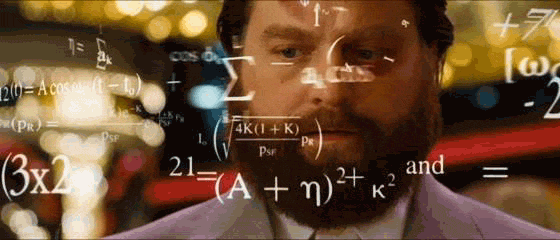In something a little different today, I'm going to discuss five simple ways data can help football teams gain an advantage. There's this idea among football's old guard that data is complicated and difficult, but the reality is, we try and provide useful insight that is easy to understand and interpret.
1) Corner Touch Maps
This is what we call a corner touch map. Marek and I designed it back in 2014 to help out with the set piece program, and it's probably the dumbest, simplest vis we'll ever build.
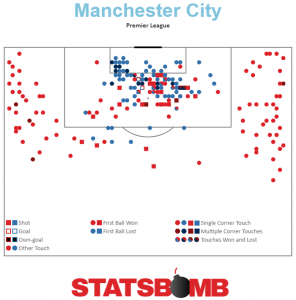
What it shows is the first touch by either team after a corner is taken.
Why?
Because I can show you a shot map of where teams have had shots off corners, but that only tells you about when they have been successful. These maps more clearly show their plan and - generally - their intended delivery zones.
Check out the map from right-sided corners from Manchester City last season.
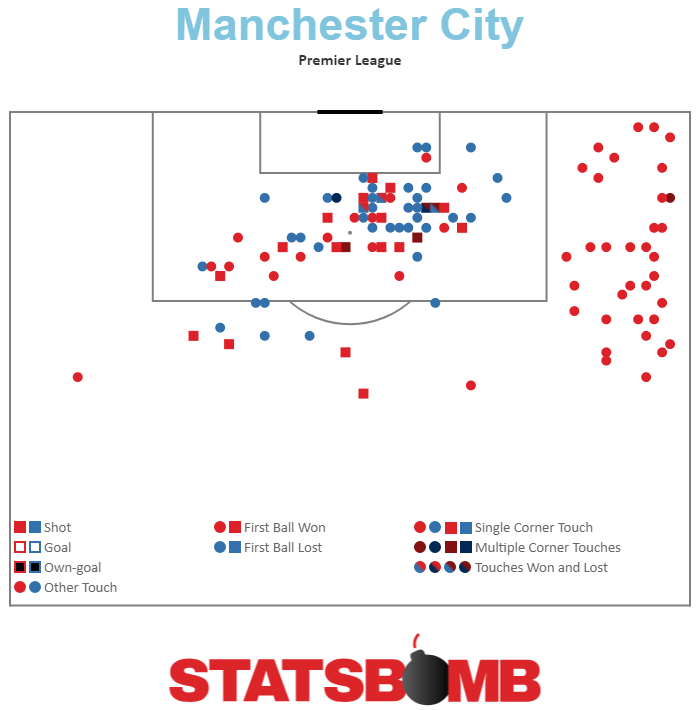
This immediately tells you two things. First, they take a lot of short corners, and you need to be ready for those. Second...
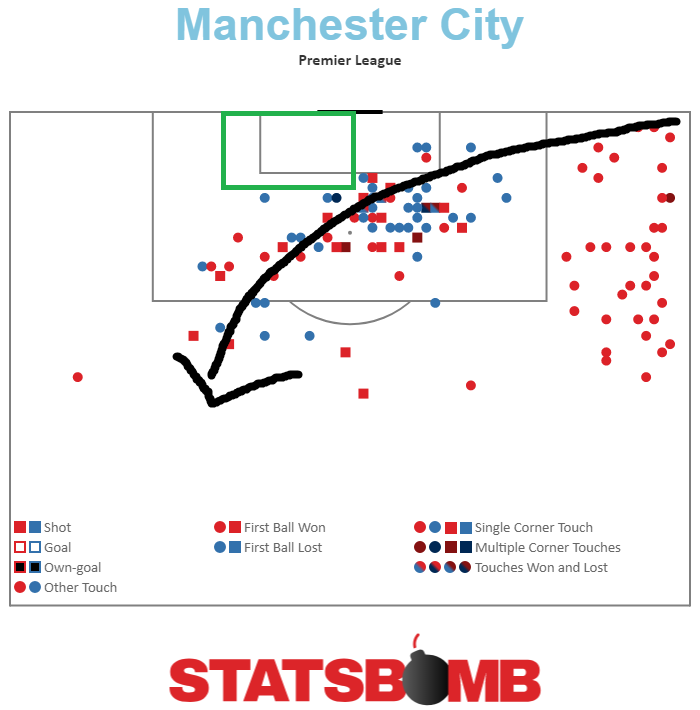
City apparently only took outswingers from that side last season, and as a result, neither team had a touch in the box on the left HALF of the six yard box.
And honestly, if I am an opposing coach facing City, my life is nearly impossible as it is, so I am thanking little baby jesus for making my life much easier by allowing me to generally ignore marking that zone (unless there are runners) and overload the zones along the curve. This is just a tiny glimpse of how we use data to help execute set pieces at both ends of the pitch.
2) Arsenal's Left Lane
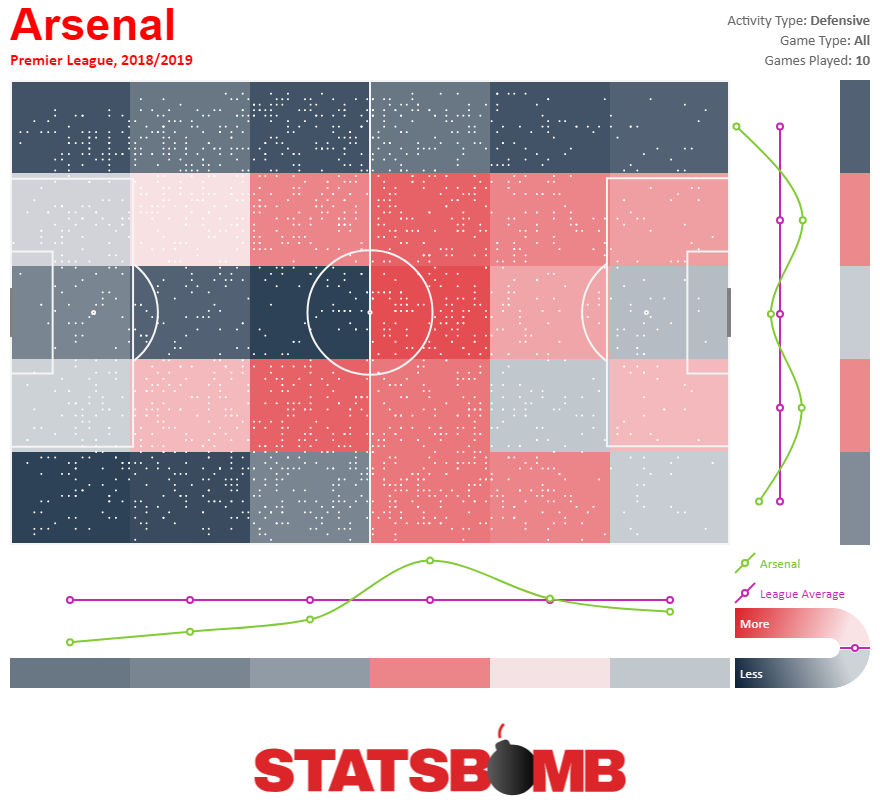
This is what we call a Defensive Activity Map. Teams are attacking from left to right. The vis attempts to profile where teams are making defensive actions (including pressures), and then compares their defensive activity in each area to the rest of the teams in the league. Zones where they make more actions than average are hotter, and zones where they have fewer actions are greyer or blue.
Arsenal this season are slanted right, possibly because of personnel issues (left back injuries), but maybe as part of a plan? This type of vis doesn't deliver a magical recipe for how to solve/attack tactical issues, but it does help coaches and analysts ask interesting questions. As a coach, I go to the video and try to figure out what is weird. If I am an analyst, maybe I compare the success of attacks down Arsenal's left compared to the right/center and see if there is a vulnerability that way.
3) Similarity Scores
We use these a lot in recruitment, largely because it's easy to talk to coaches about who their ideal player for a position is as opposed to all of the precise things they need that player to do on the pitch.
Once you know which players fill their ideal archetypes, you can then dig into the data for what those players do on metrics you care about, and then plonk down a list of players to scout in the leagues you can afford.
Coach, who is your ideal wide forward?
"I want Lionel Messi."
(Seriously - this always happens. Every coach says this exact same joke.)
And because we are indulgent number wonks who have this already set up in StatsBomb IQ, we can answer the question honestly.
The most similar players to Messi 17-18 in our current data set are:
Neymar Messi (18-19 edition)
Eden Hazard
Raheem Sterling
and Nicolas Pepe, who has been on fire so far this year.
But the fun part of this is that you can actually narrow down the data to the leagues you can afford to buy players in and still have the exact same conversation.
Who is the Lionel Messi of League One? 2017-18 Bradley Dack, maybe? Or Conor Chaplin?
How about in Austria Bundesliga? Uh... Andrei Ivan?
Look, I'm not saying the data is always right in these situations, but shopping for the poor man's Messi apparently comes with serious limitations.
4) Evaluating Goalkeepers
On Monday, we released phase 1 of the Goalkeeper Module into StatsBomb IQ. It allows teams to profile goalkeepers statistically across a broad range of metrics that haven't really been available before because in other data sets, we never knew where the keeper was when a shot took place.
We were messing around with some of the visualisations in testing and came across this fun one for last year. David De Gea and Joe Hart faced almost exactly the same amount of xG in shots on target last season, but how that xG came about and what happened after that was dramatically different.
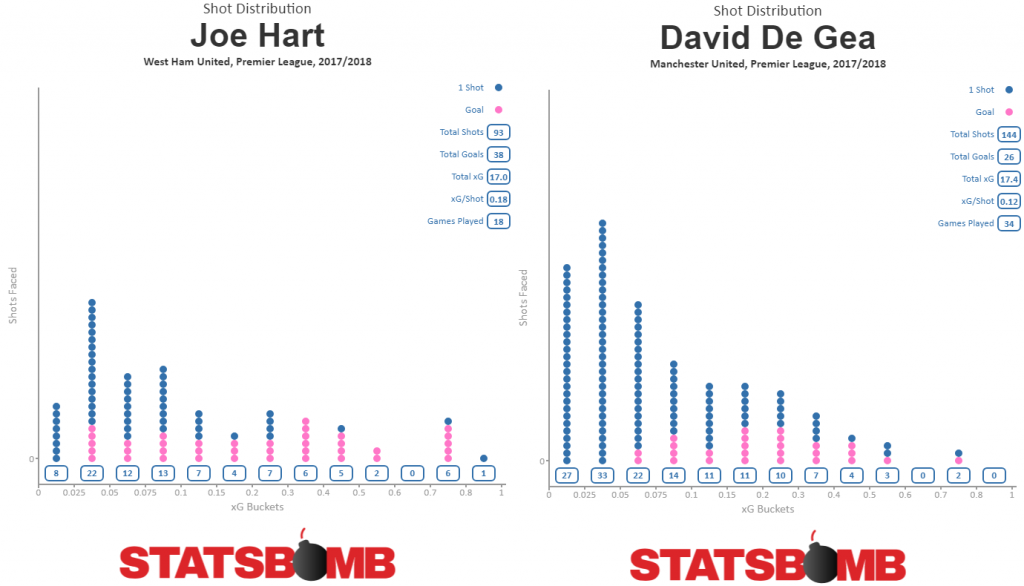
The vis above is broken into xG buckets, and you'll notice that the shots Hart had to content with were generally much higher quality than those De Gea dealt with. Sadly, nearly every high xG shot Hart faced also made it into the back of the goal.
When it comes to analysing and evaluating GKs with stats, we're just getting started. Expect to see a lot more from us on this topic in the coming weeks.
5) Passing Tendencies at the Team and Player Level
TL;DR
Stats don't have to be complicated to deliver powerful, useful insight. And often the simple stuff is the most effective IF you know where to find it.
Ted Knutson ted@statsbomb.com @mixedknuts
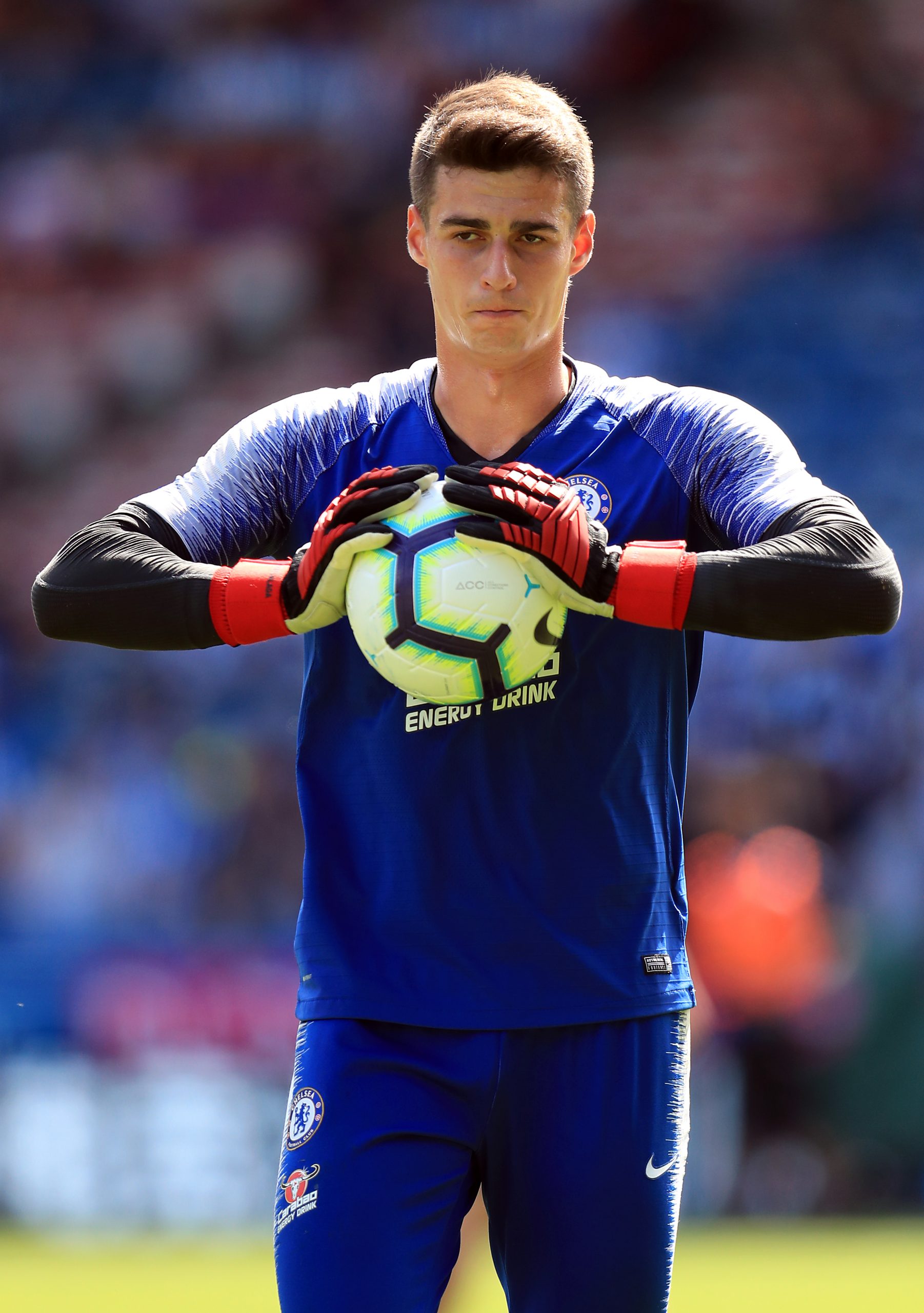
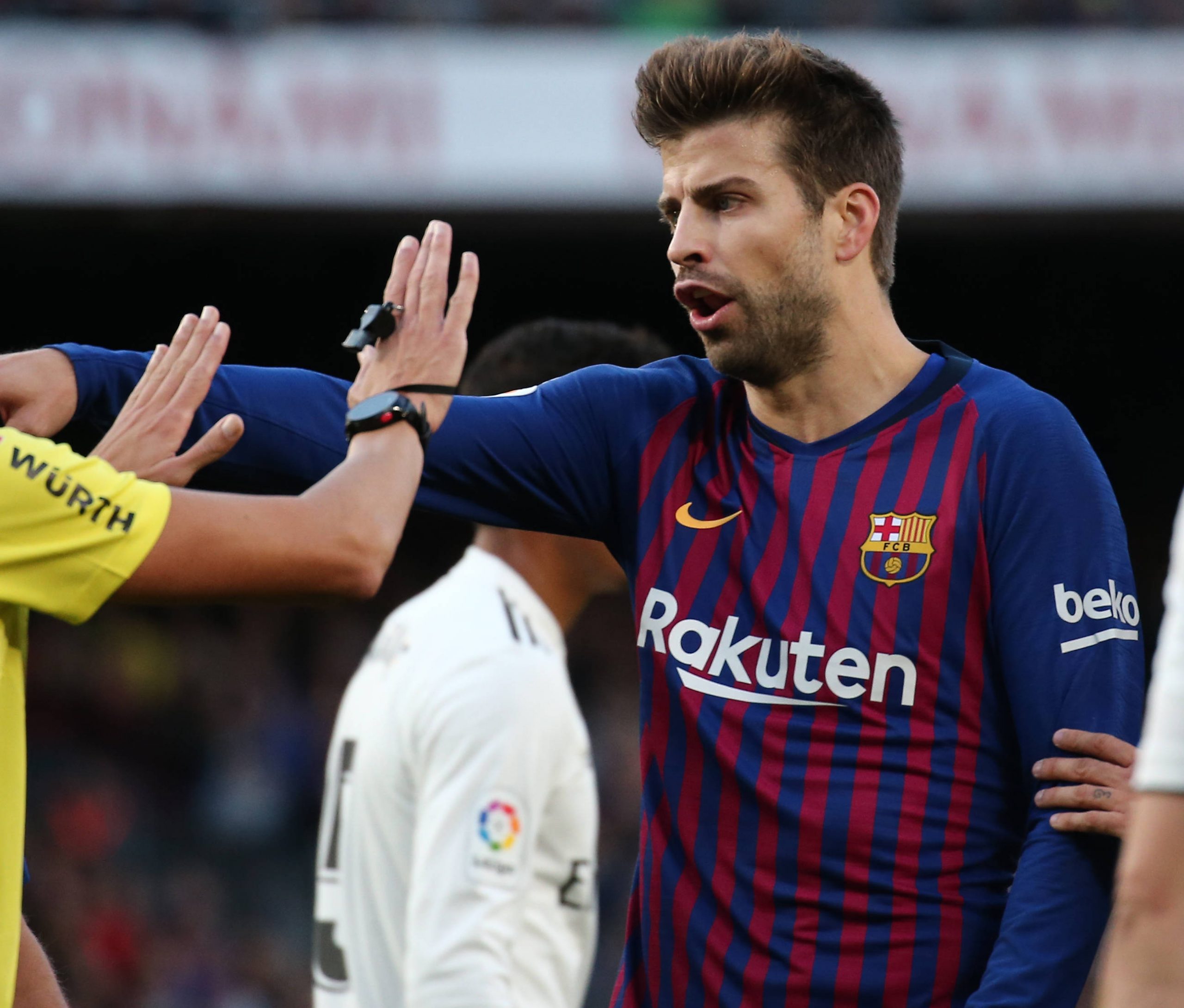
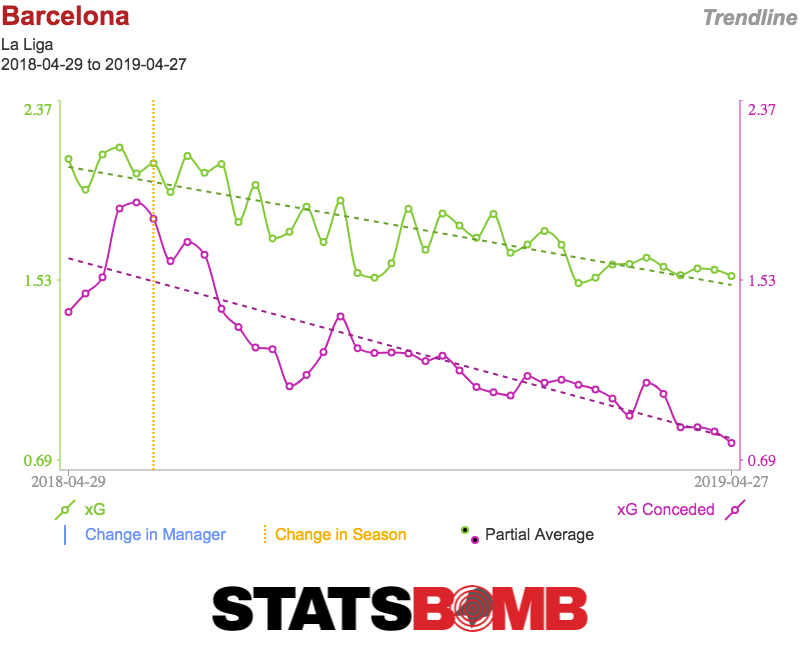
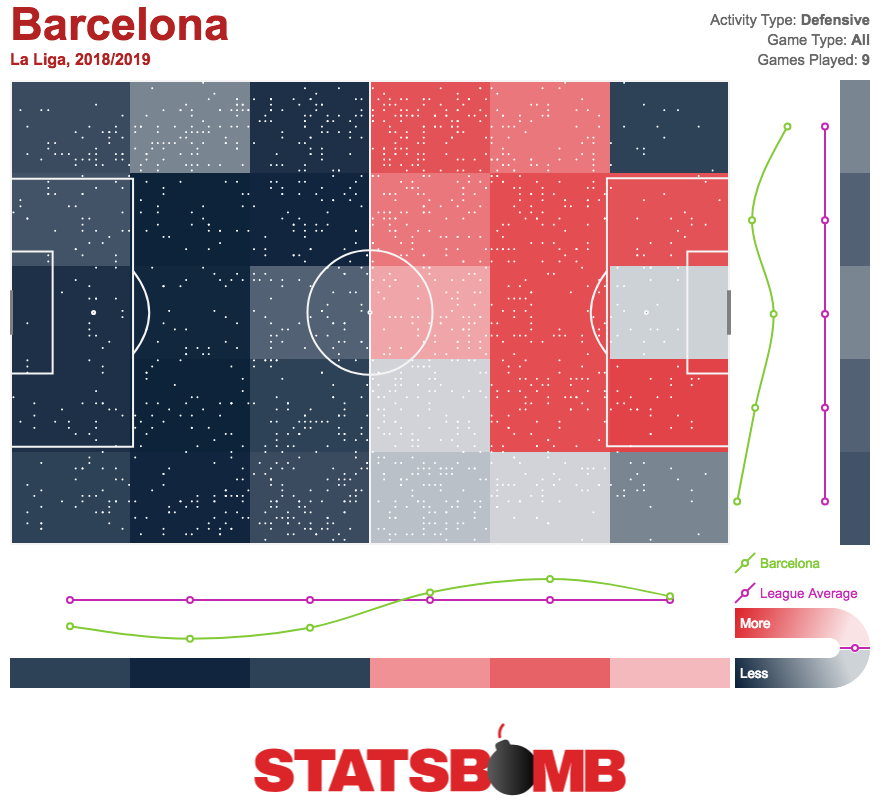
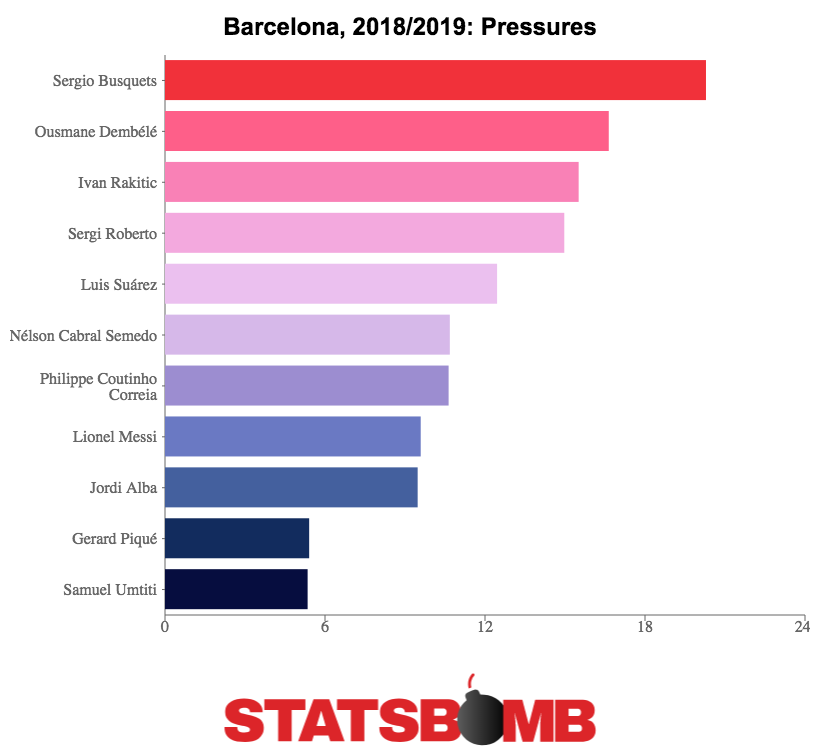
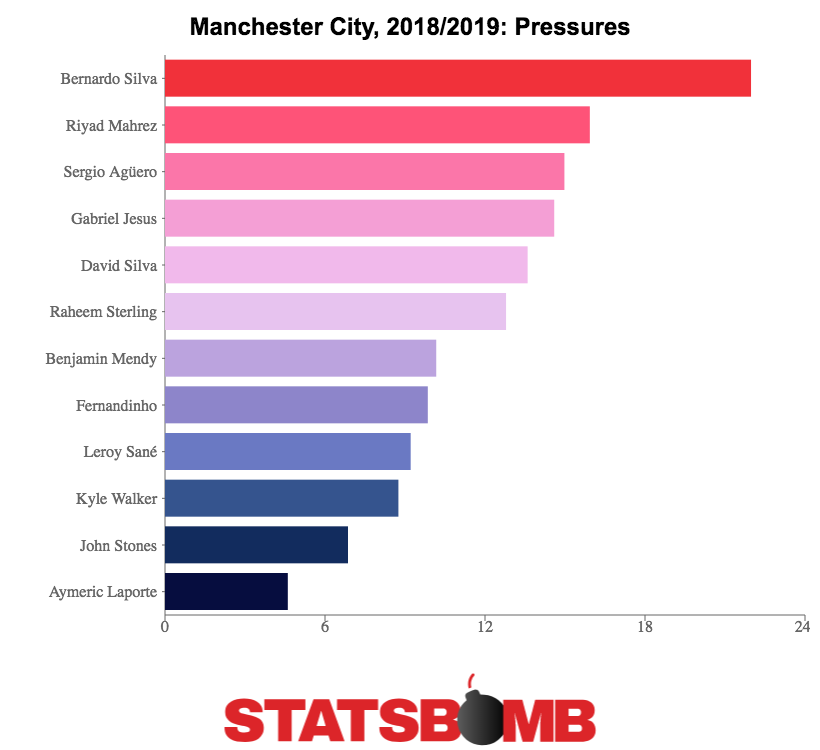
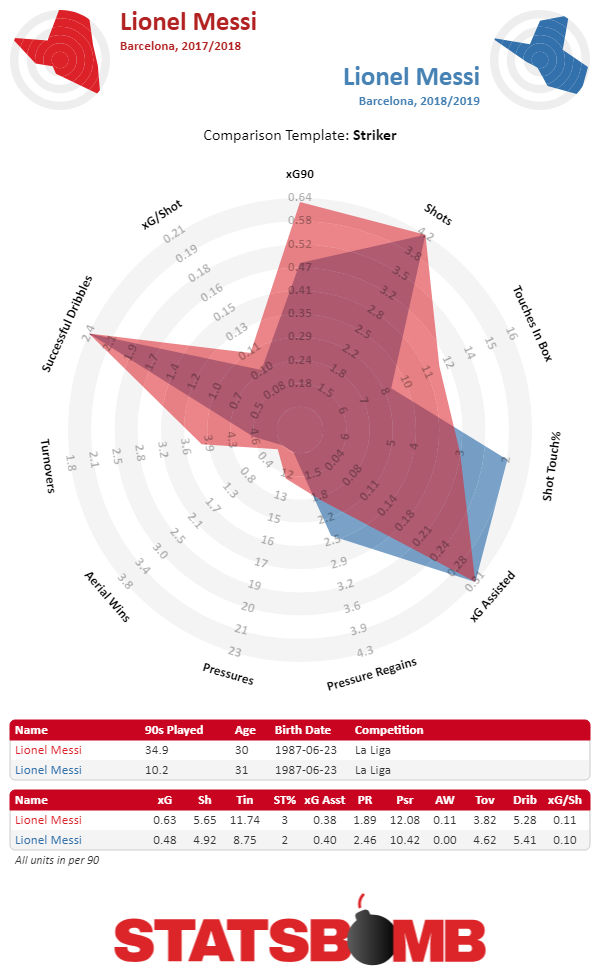
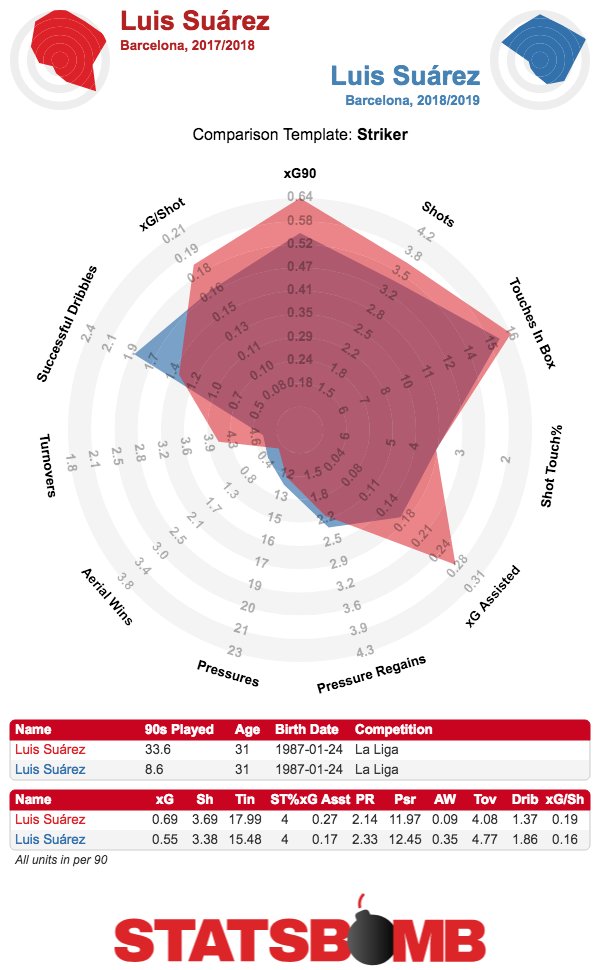
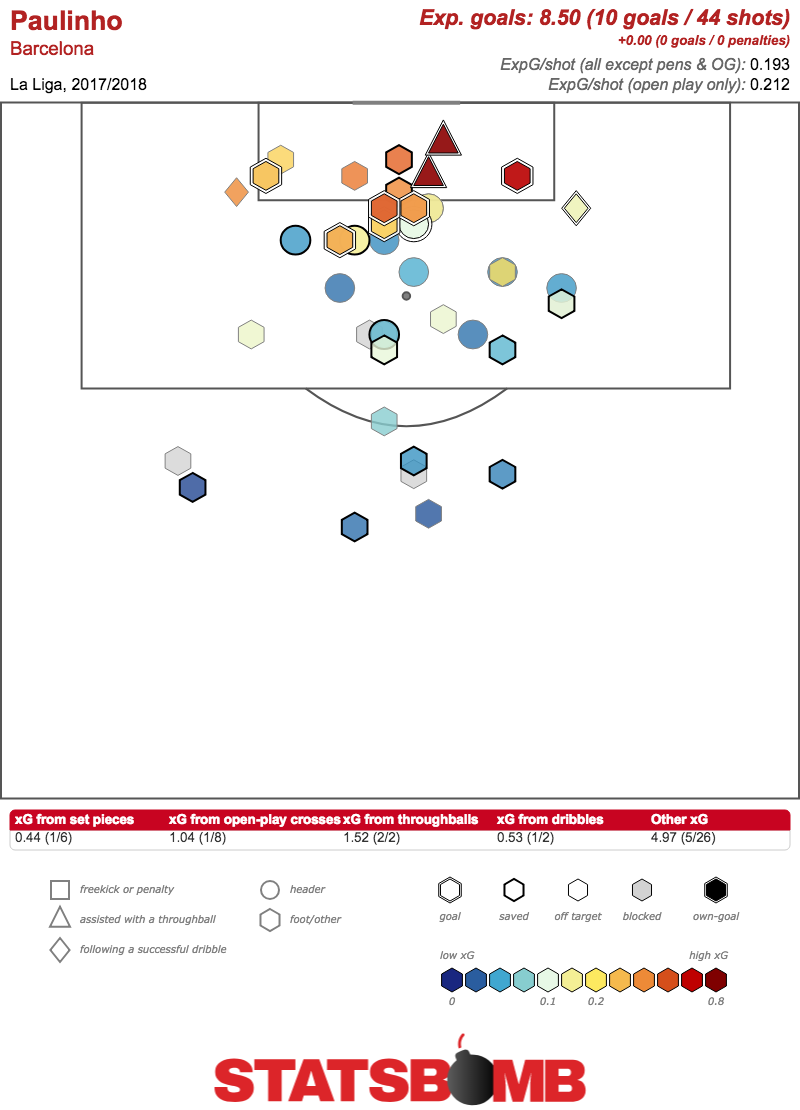
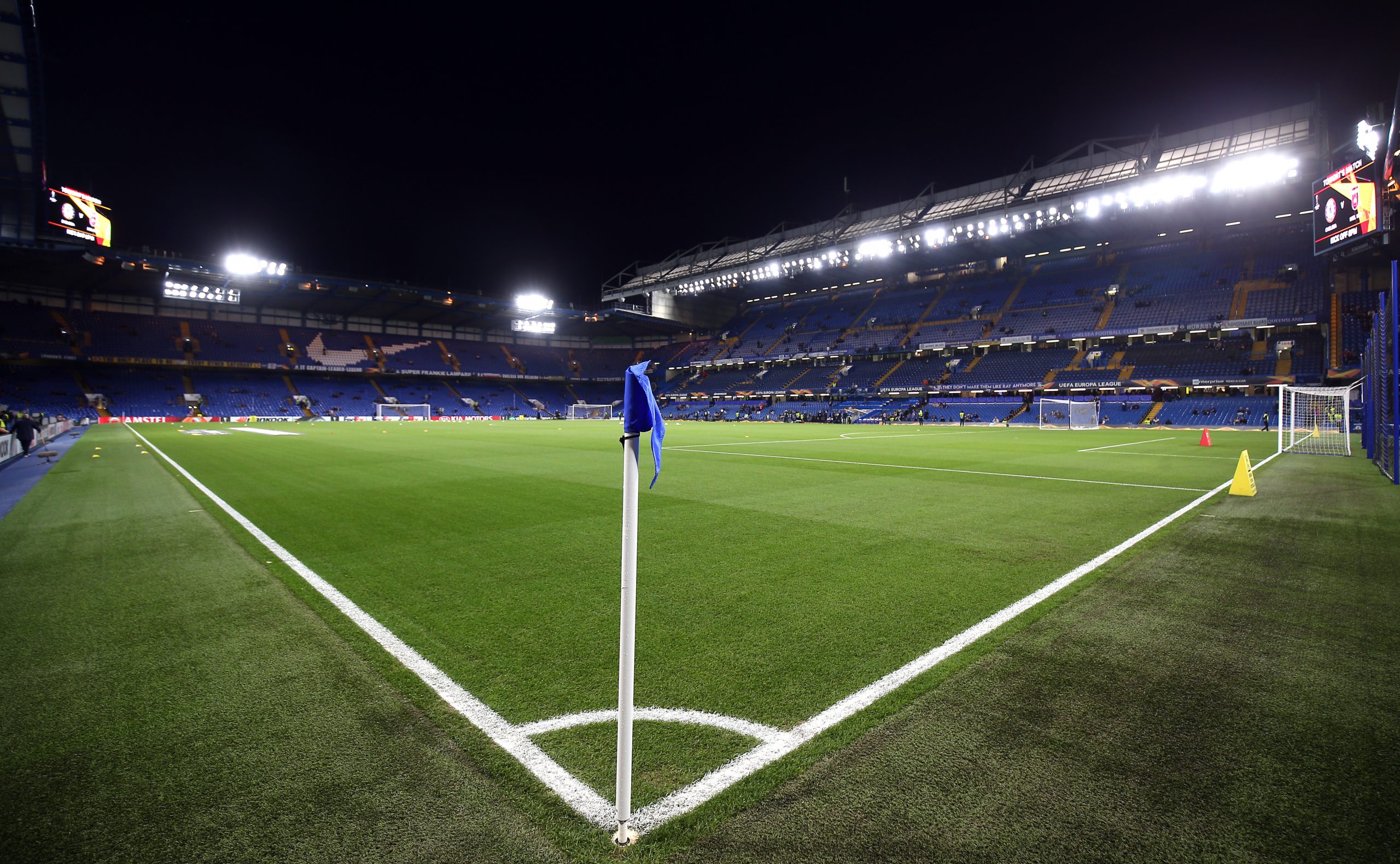
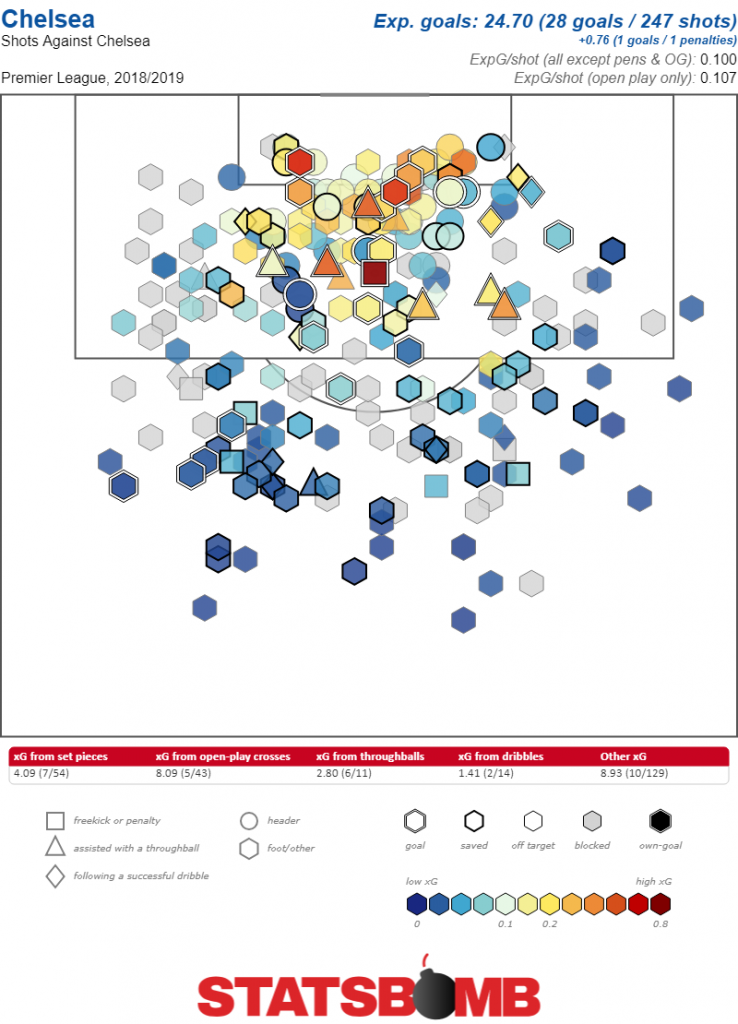
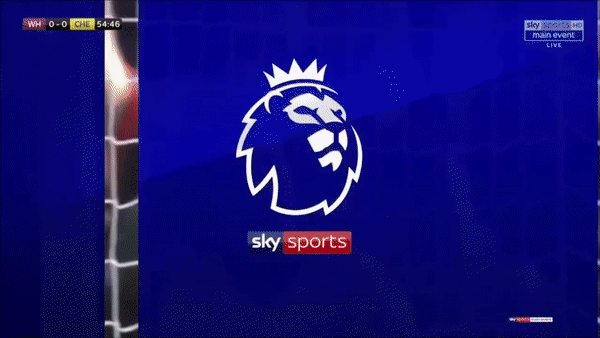
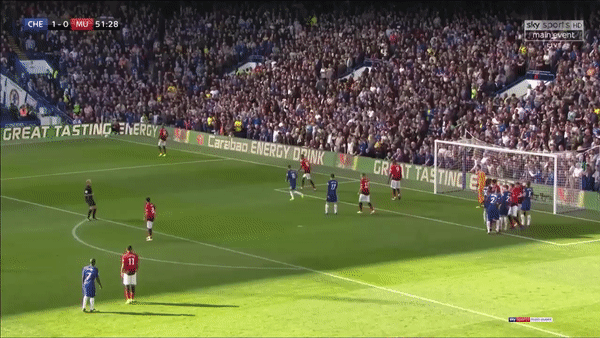
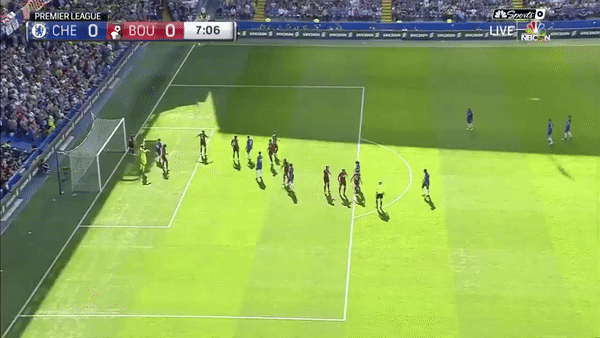
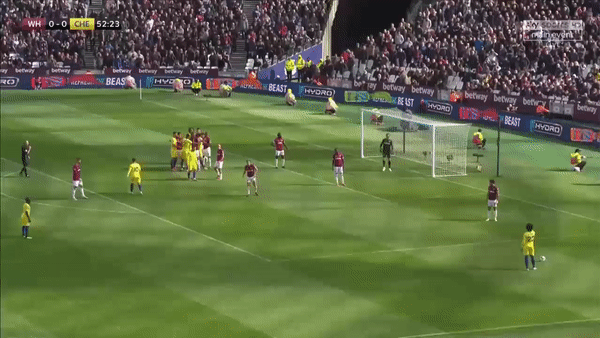
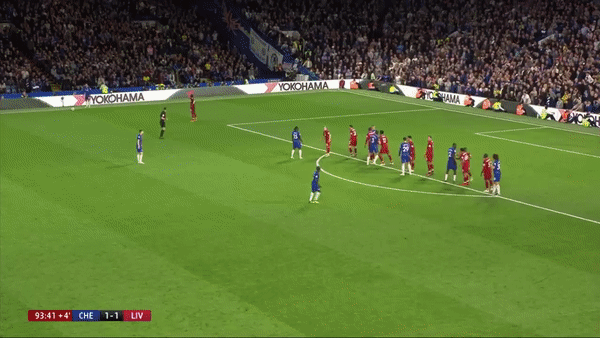
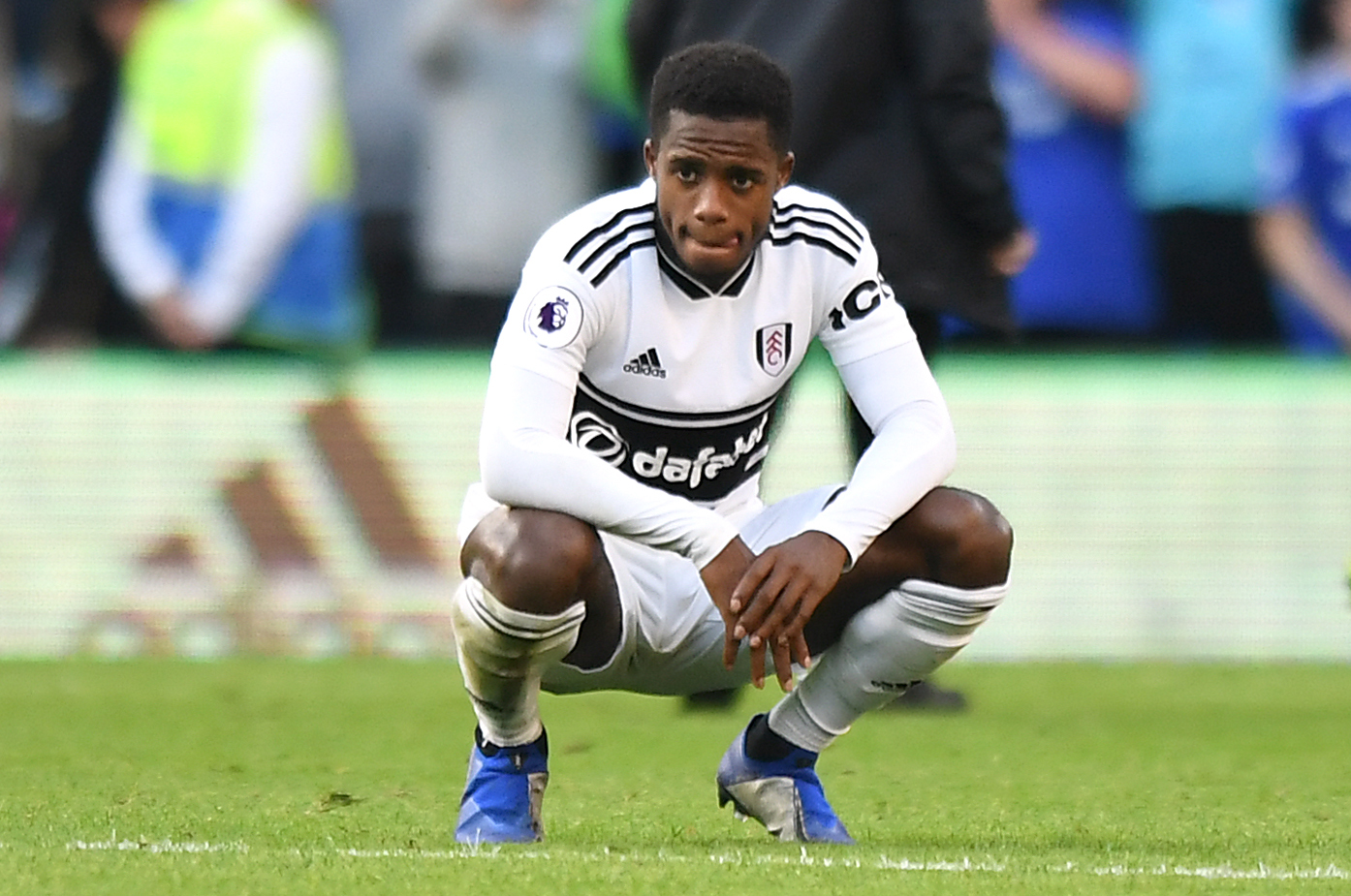
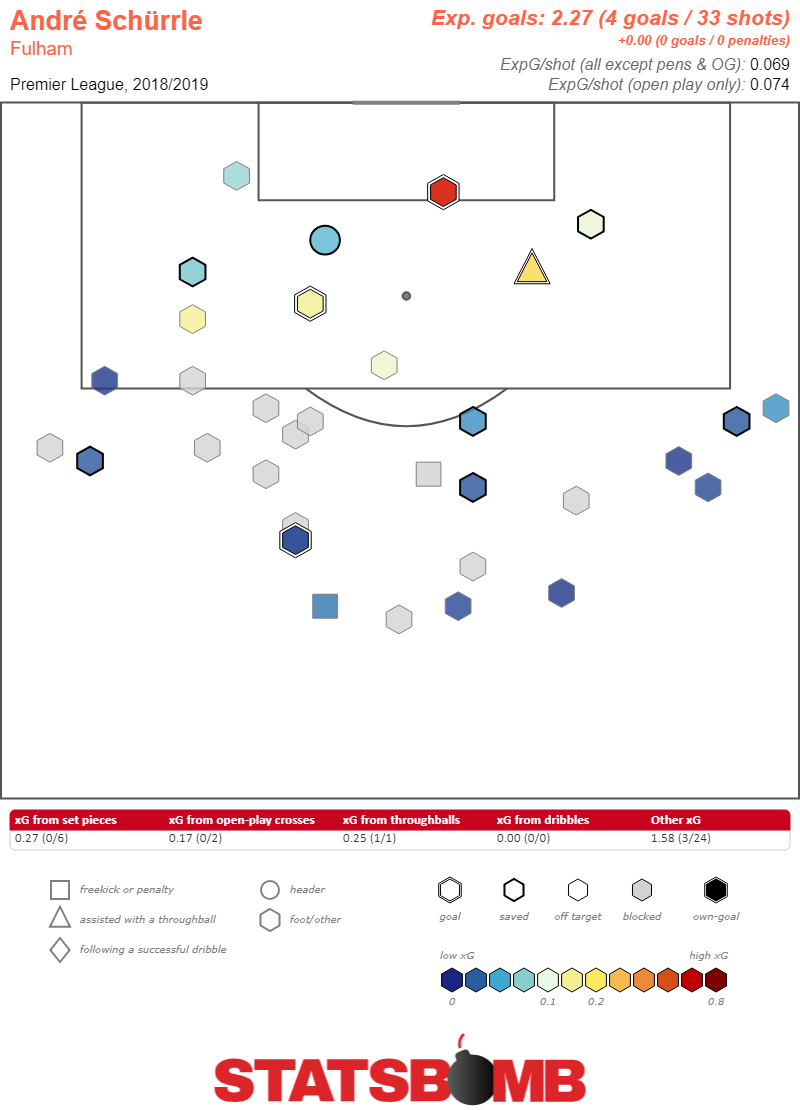
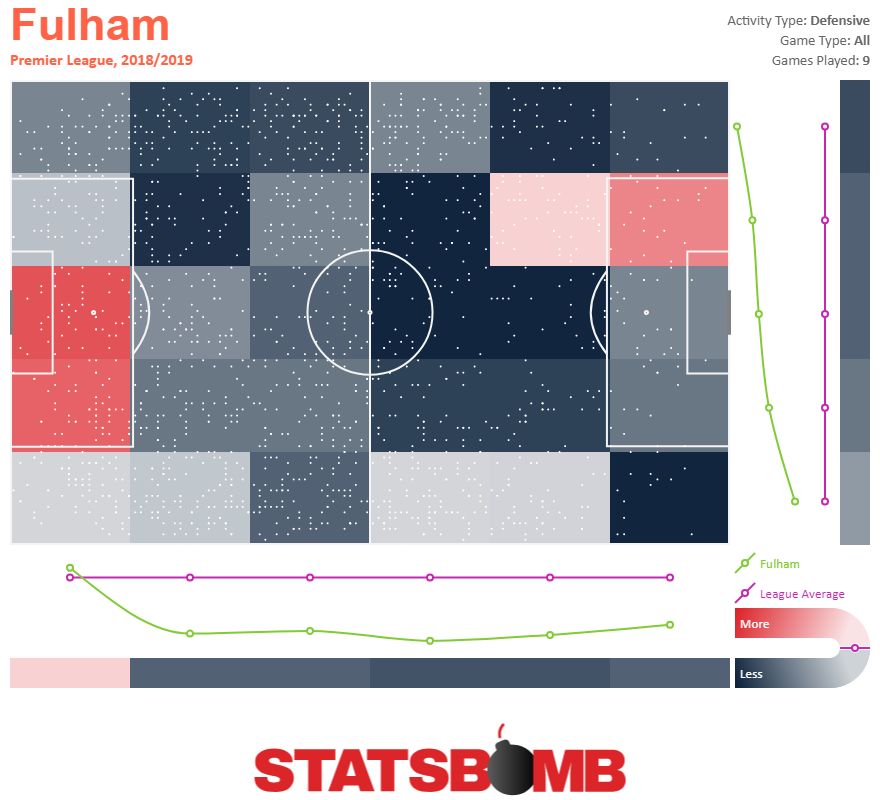
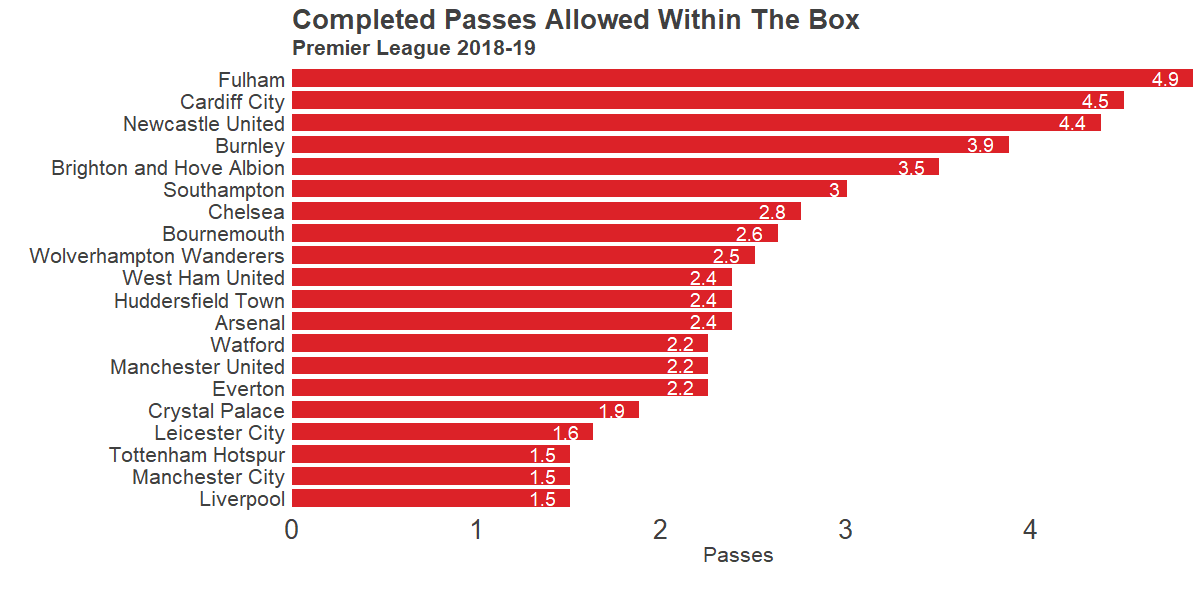
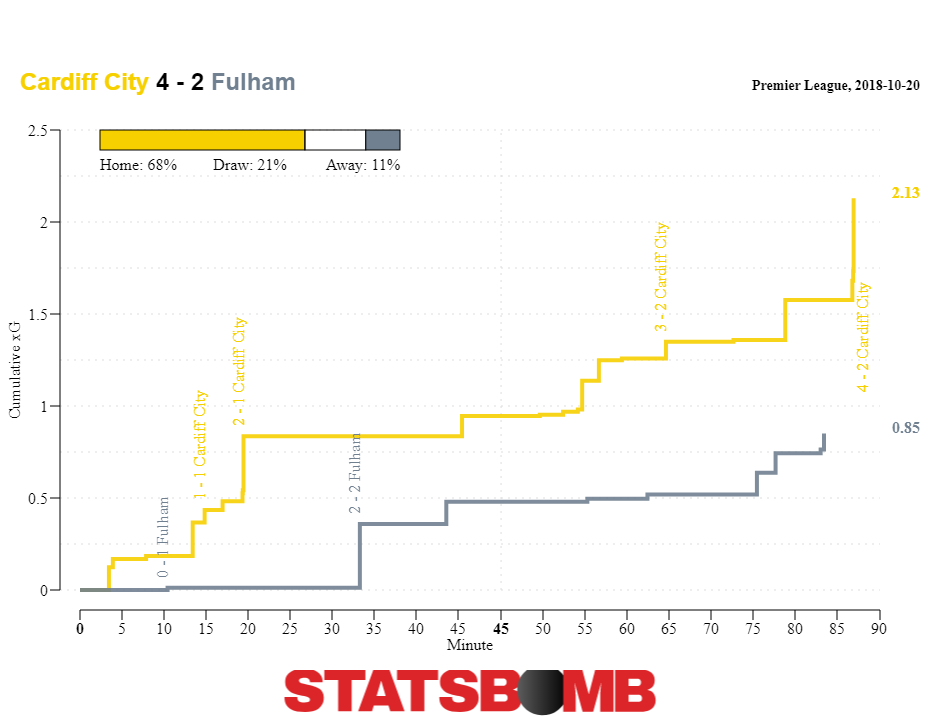
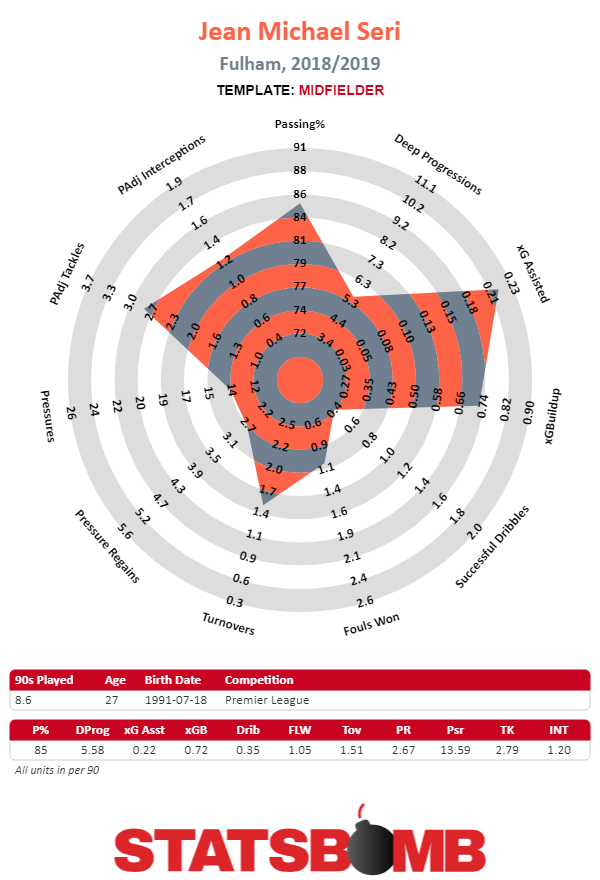
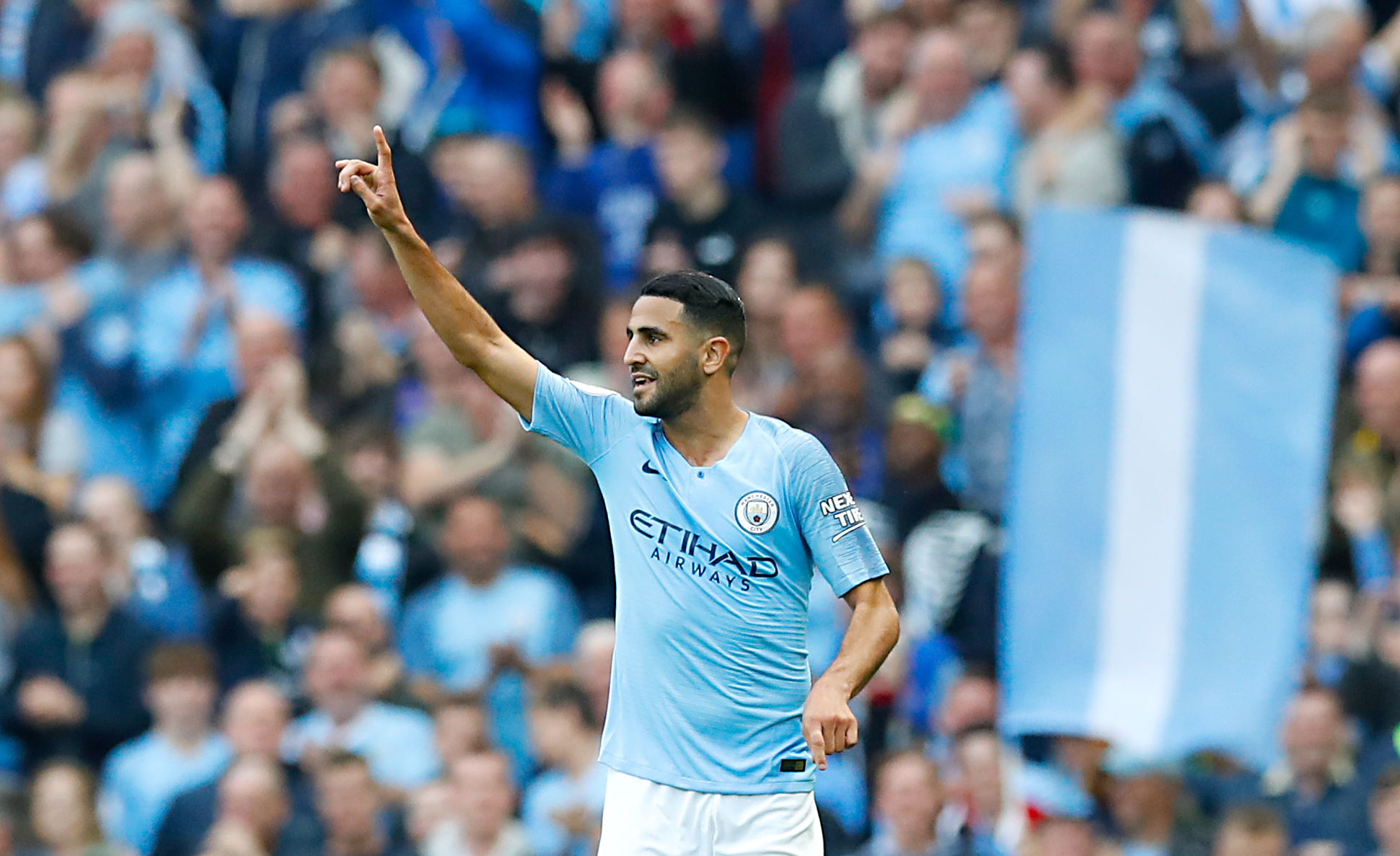
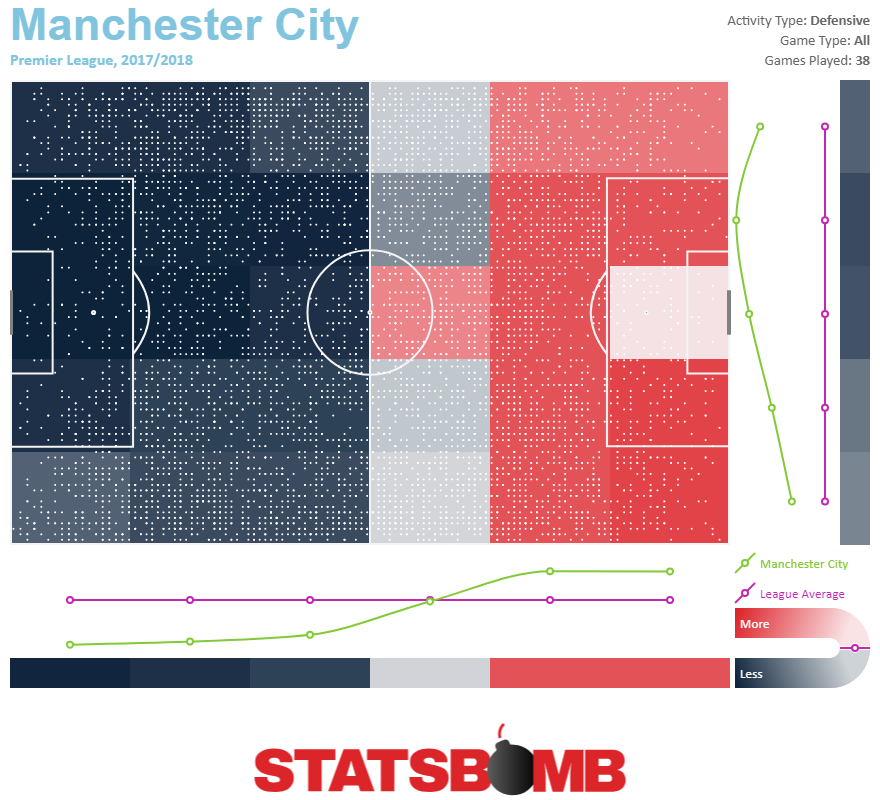
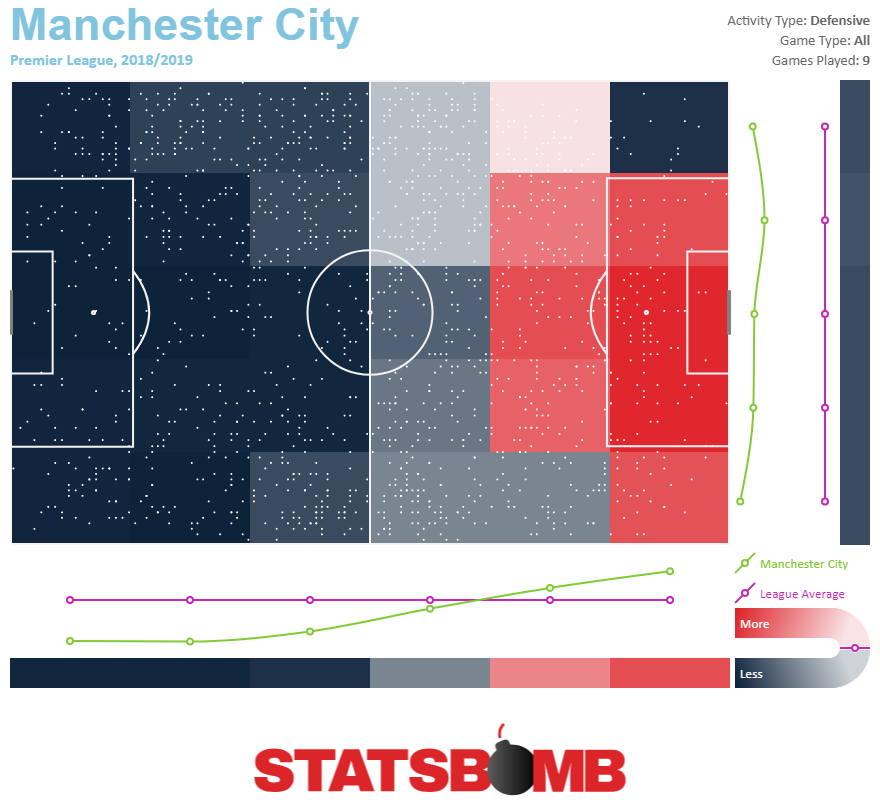
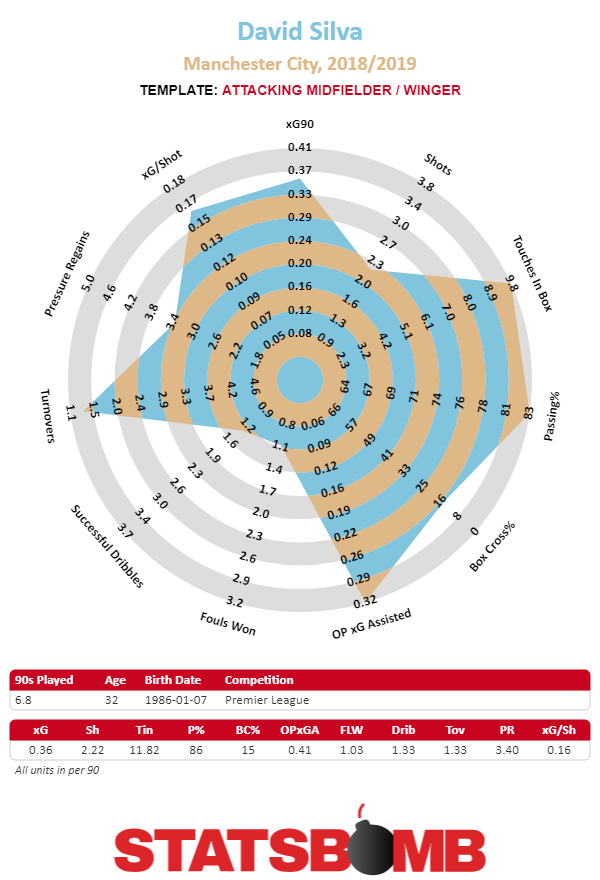
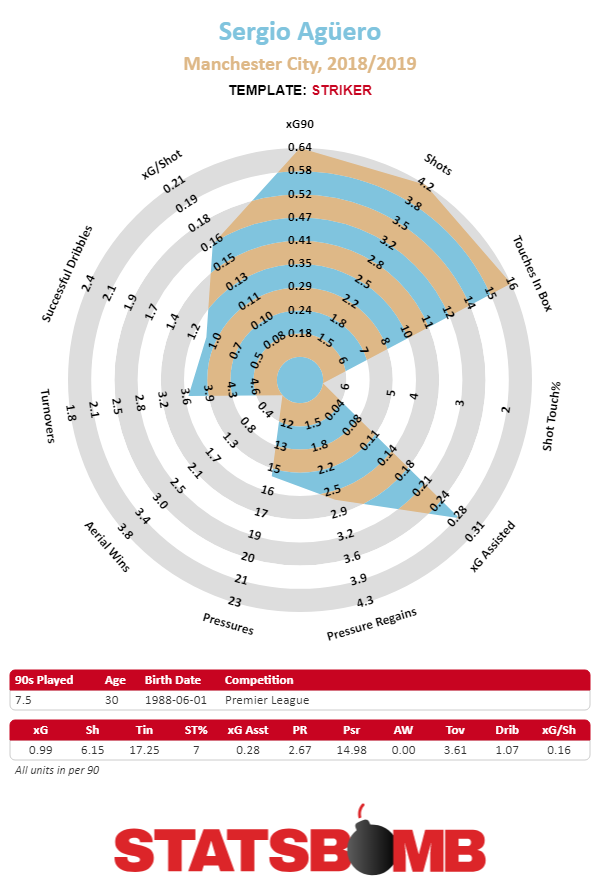
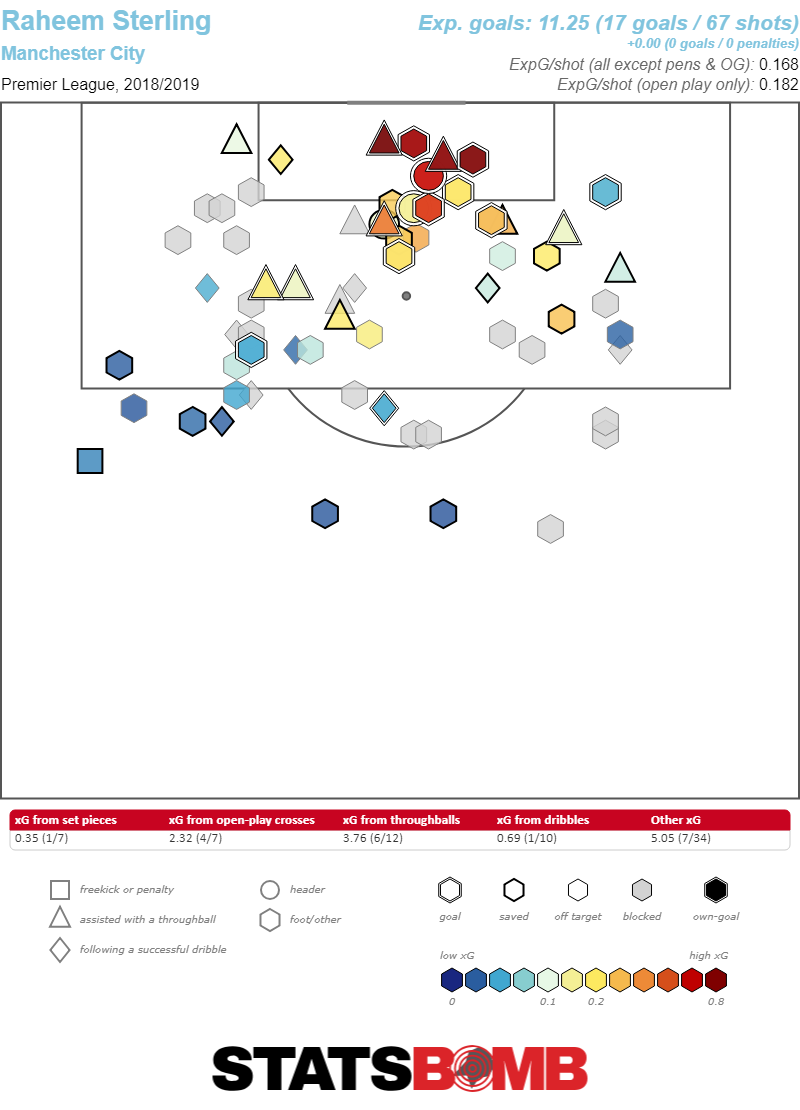
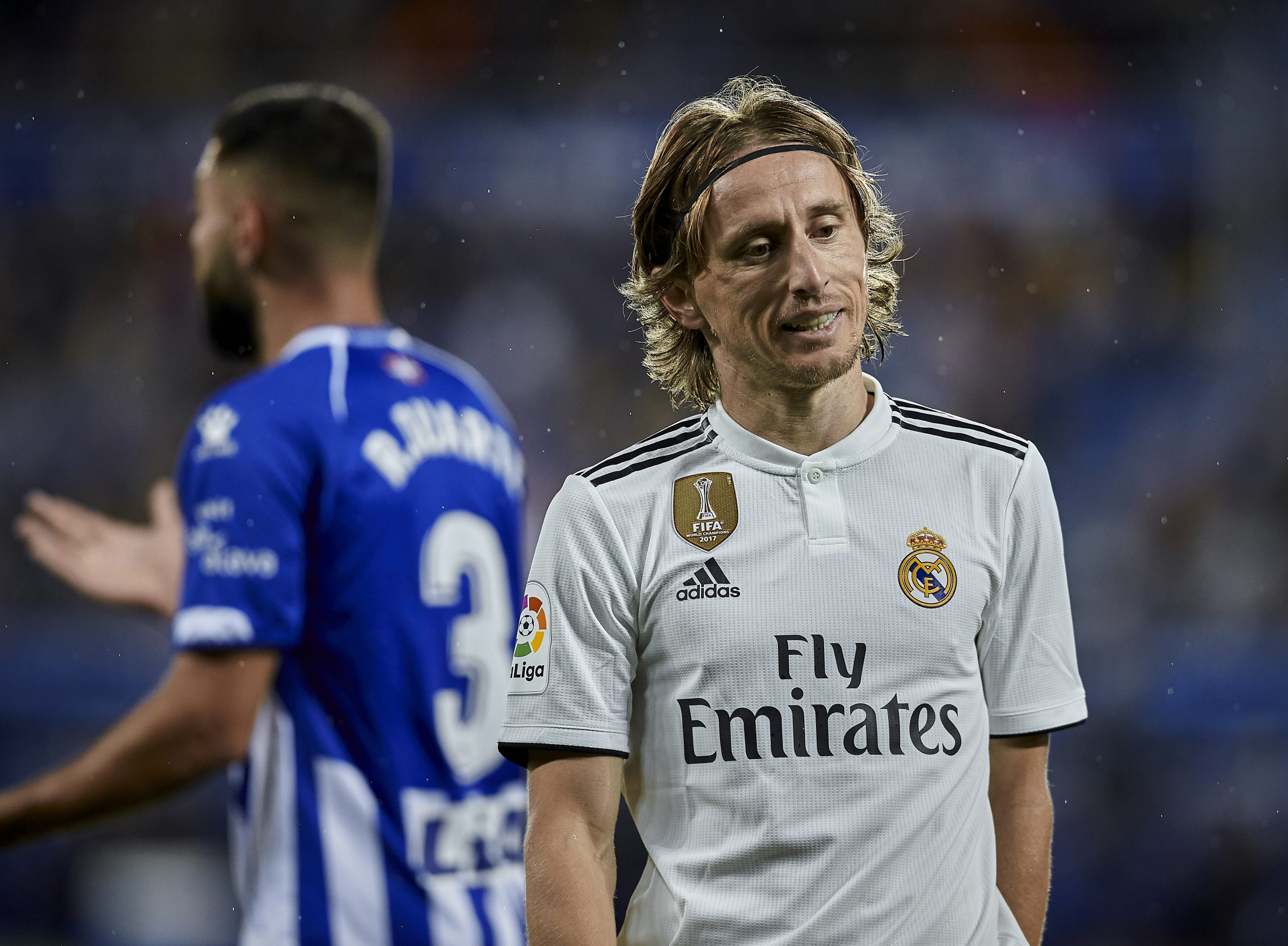
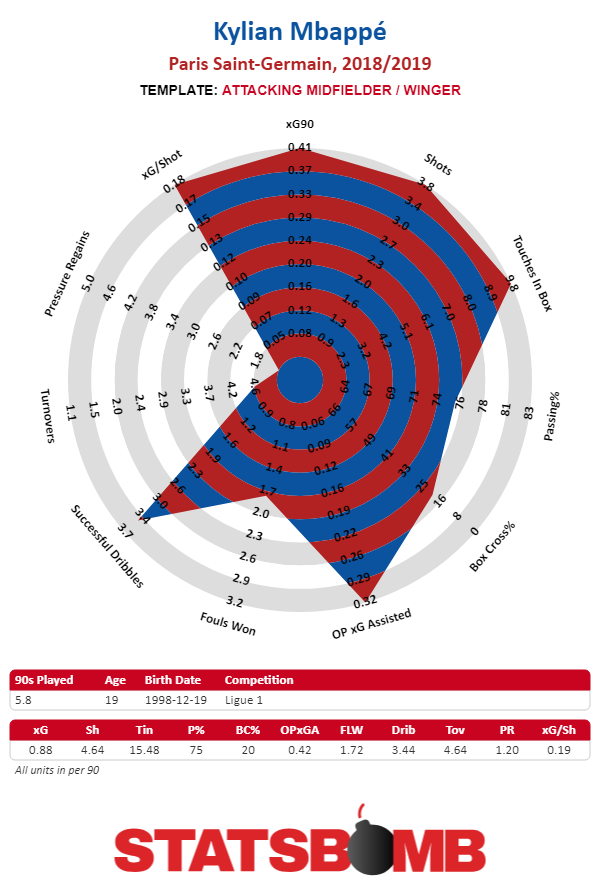
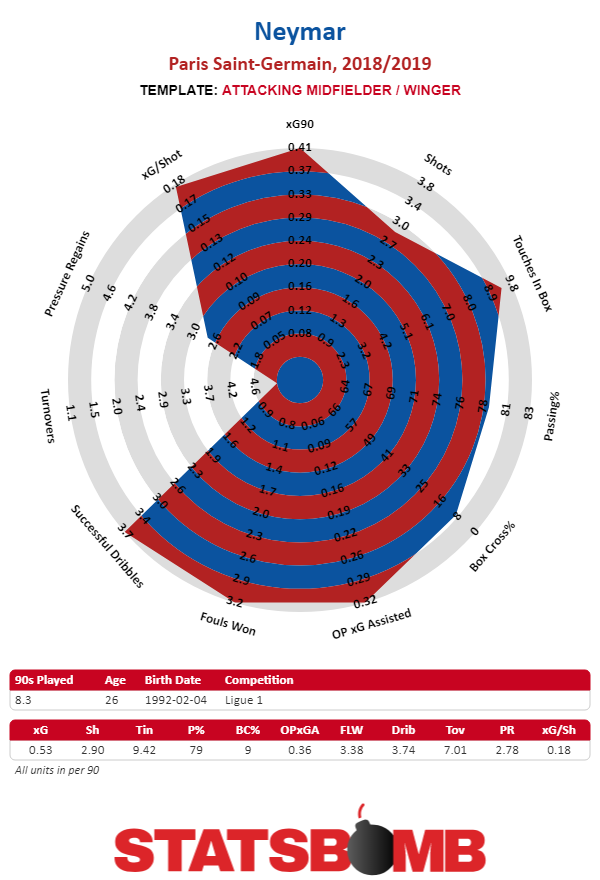
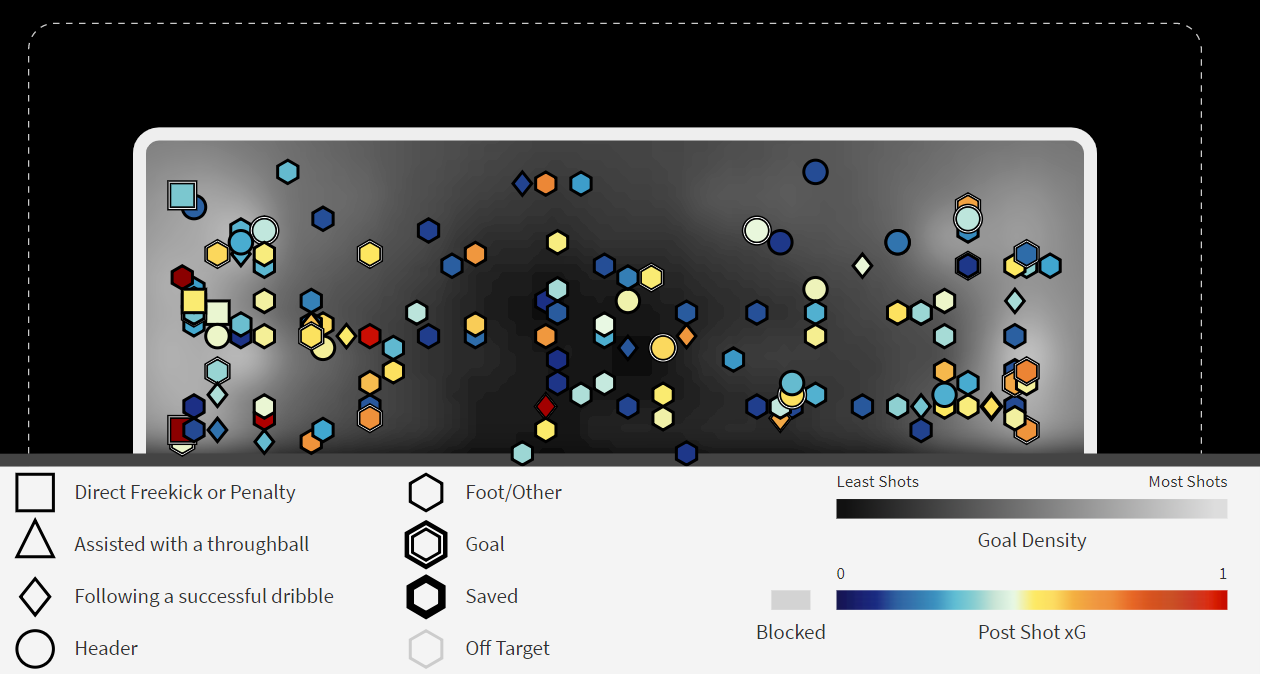
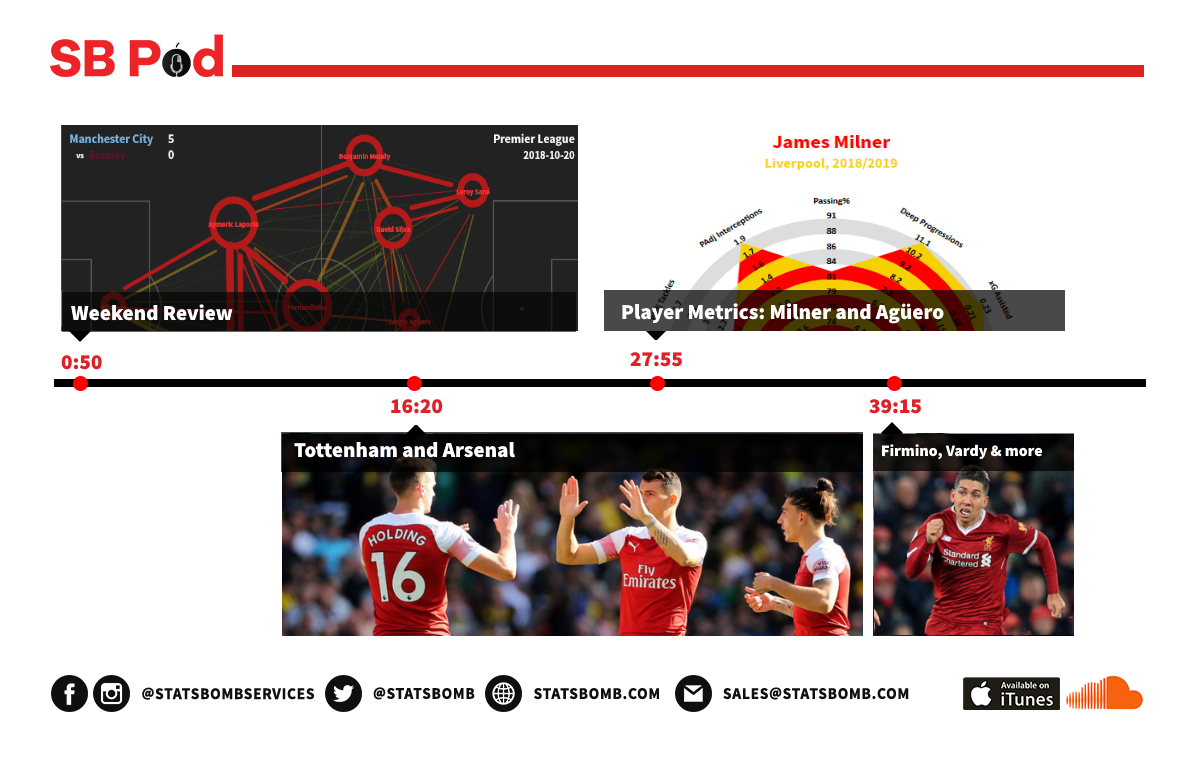
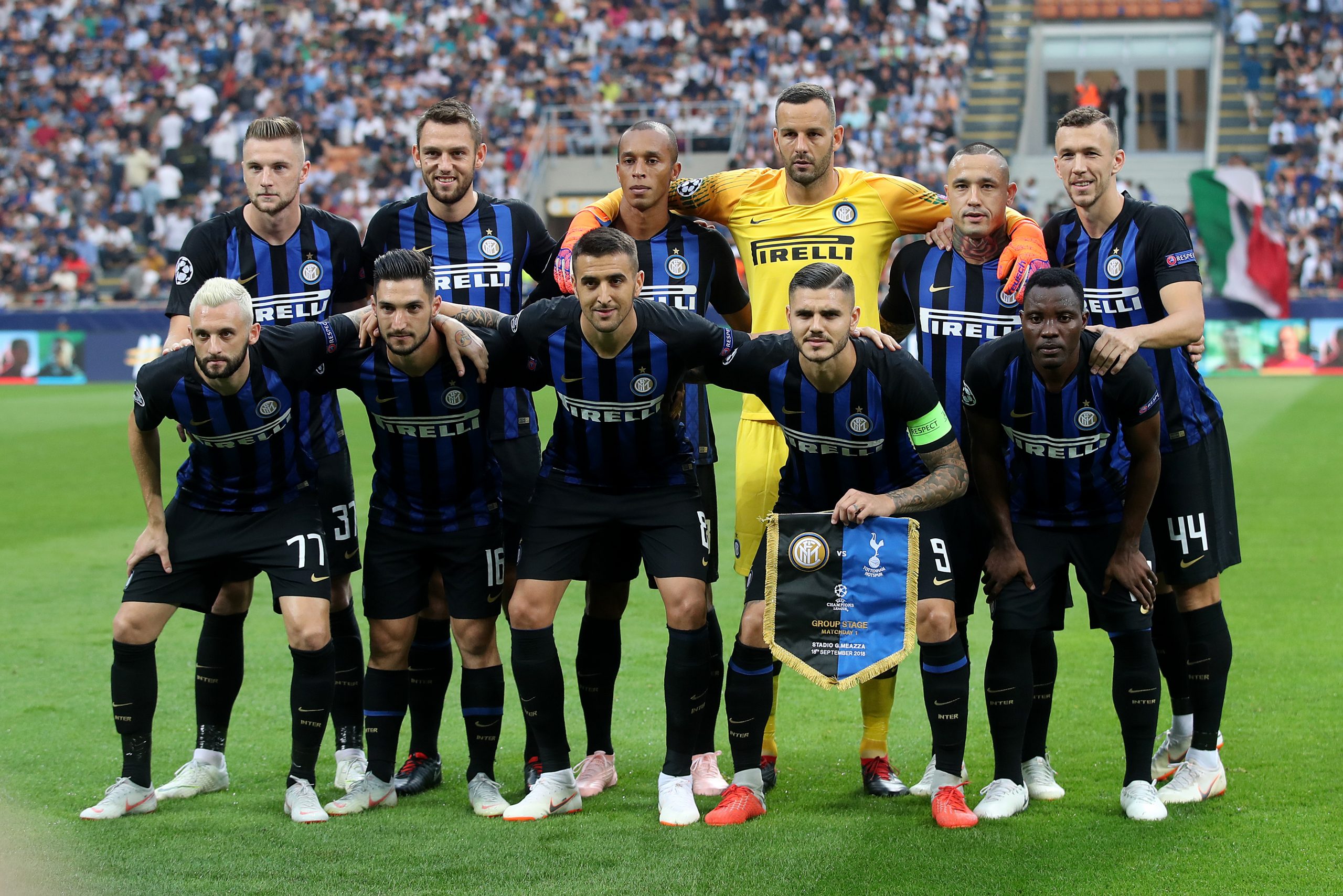
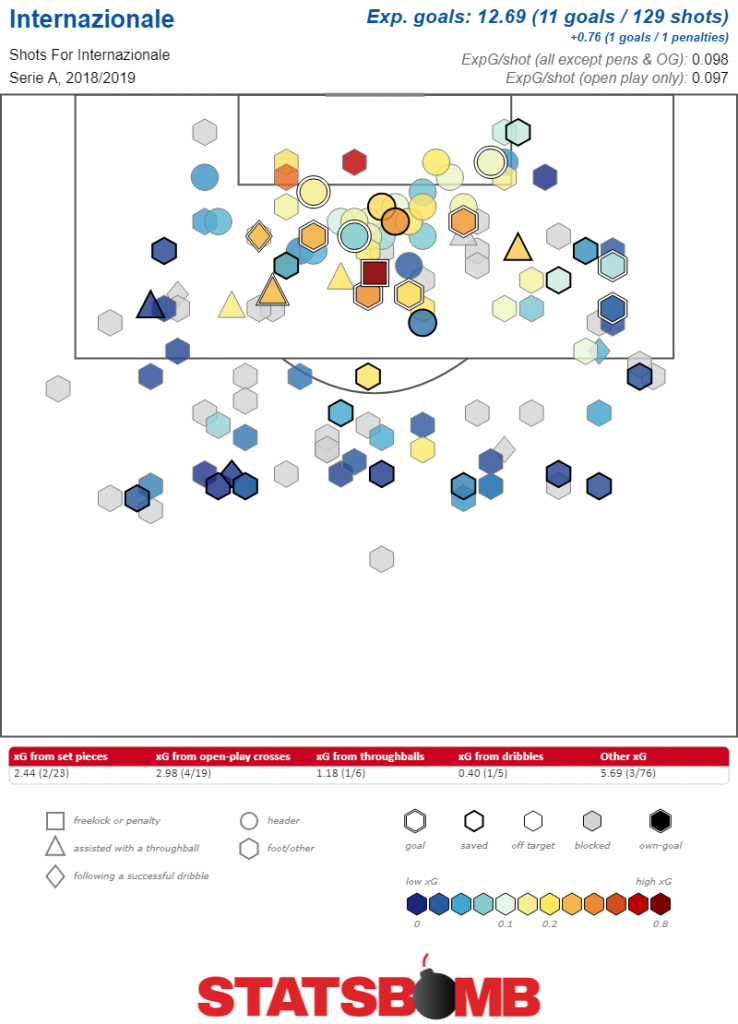
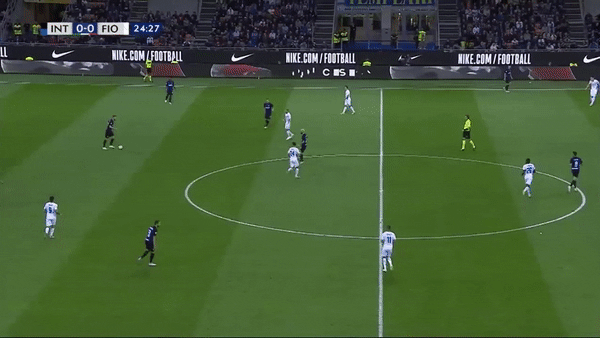
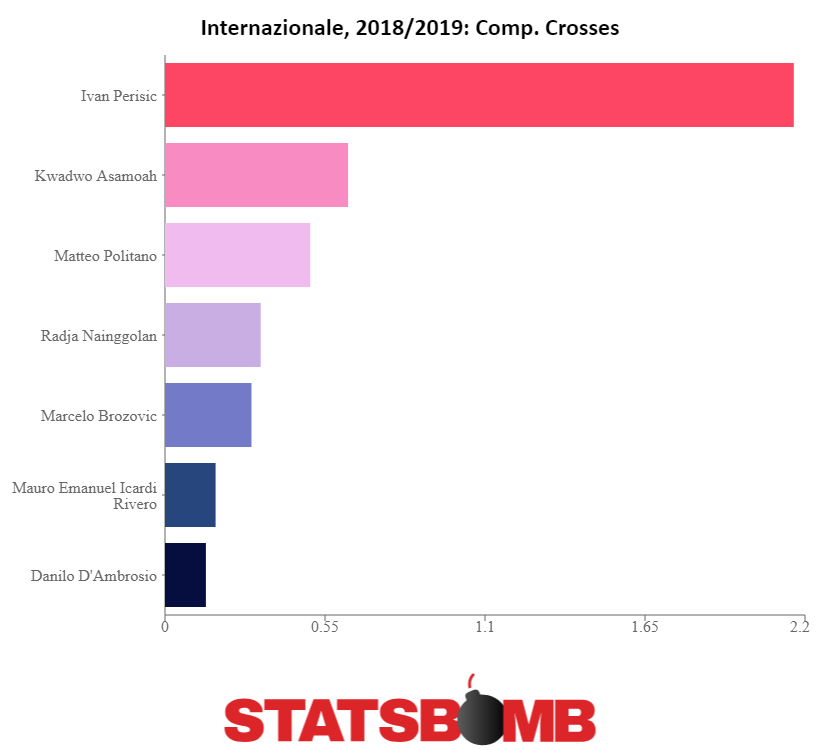
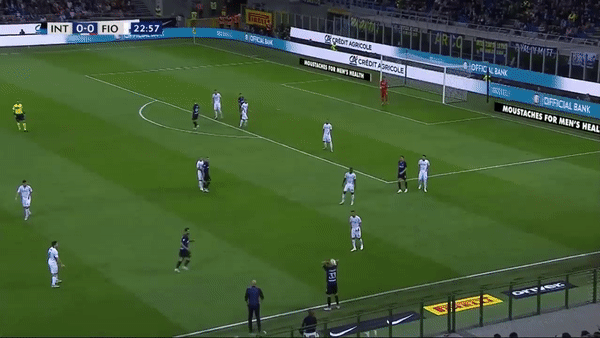
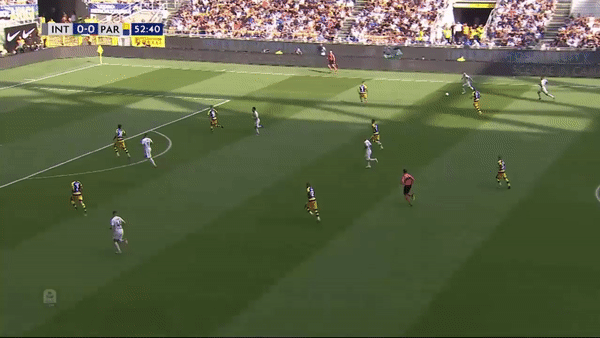
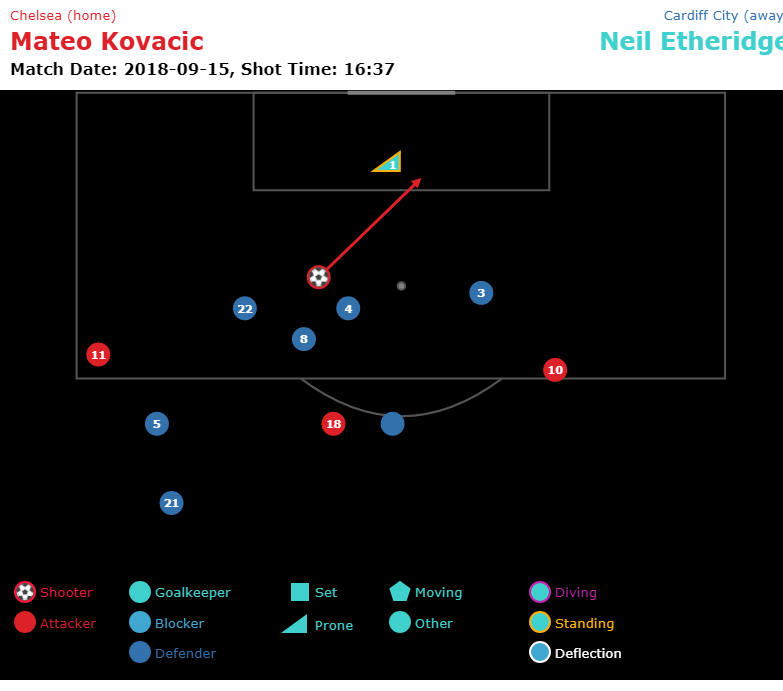
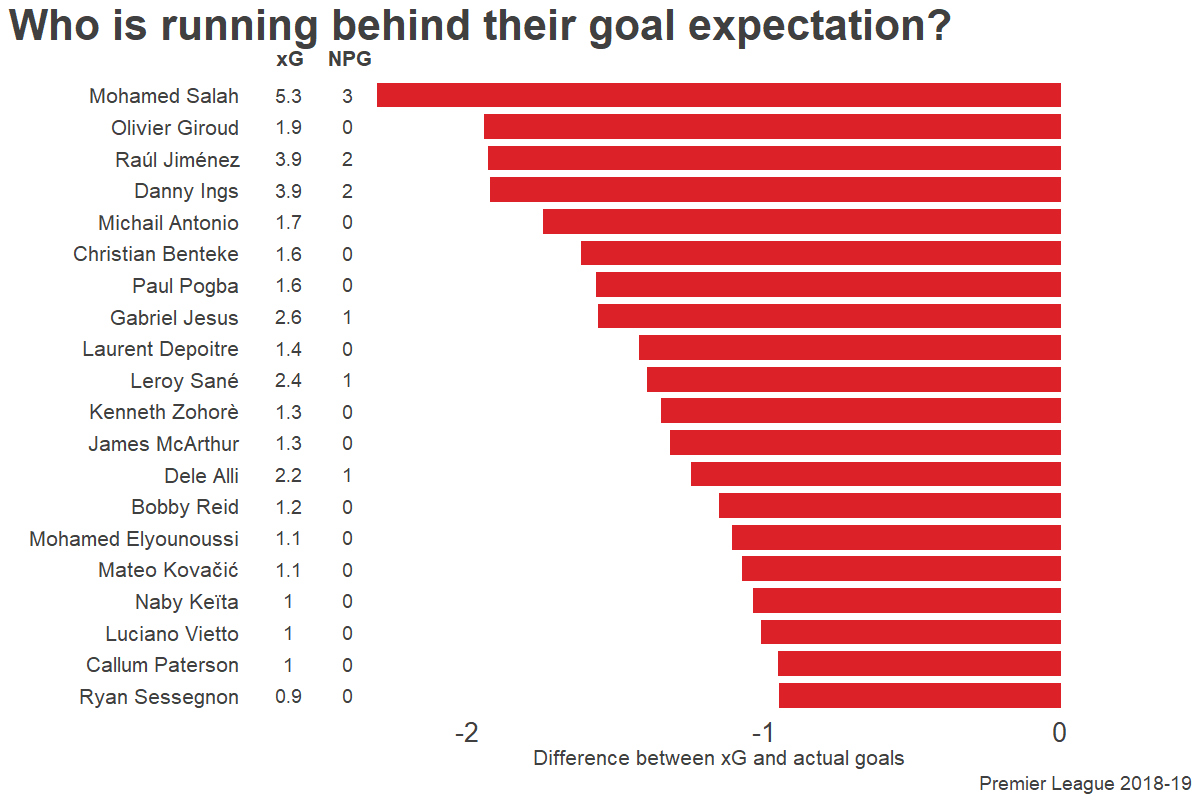 The list consists of a handful of different kinds of players. There are the great players who take a lot of shots. Those are the guys you really shouldn’t worry about. Mohammed Salah is totally fine, he’s just missed a few shots. Granted, the city of Liverpool seemingly went an entire season without being subjected to the indignity of Salah missing a good chance, but it really does happen to everybody. Dele Alli and his lone goal show up here as well. But, similar to Salah, Alli has a long track record of good goal scoring rates, he’s still doing all the other things that make him a wonderful player and if he’s healthy and on the pitch Spurs should have no concerns about him eventually coming good. The pair of Manchester City attackers on this list also should raise zero signs of alarm. It’s incredibly that Leroy Sane and Gabriel Jesus have even generated enough chances to make this list. Between them they’ve barely played 600 minutes. Sane has taken 10 total shots, Jesus has taken 15. The fact that they’ve both missed a couple of really good chances and ended up on this list is more indicative of just how bananas good Manchester City’s attack is, and how fast and furious the great chances are flying over at the Etihad than of anything potentially problematic with Sane and Jesus’s games. Elsewhere on the list are a handful of truer midfielders. Paul Pogba is here. He’s yet to score any non-penalty goals this season.
The list consists of a handful of different kinds of players. There are the great players who take a lot of shots. Those are the guys you really shouldn’t worry about. Mohammed Salah is totally fine, he’s just missed a few shots. Granted, the city of Liverpool seemingly went an entire season without being subjected to the indignity of Salah missing a good chance, but it really does happen to everybody. Dele Alli and his lone goal show up here as well. But, similar to Salah, Alli has a long track record of good goal scoring rates, he’s still doing all the other things that make him a wonderful player and if he’s healthy and on the pitch Spurs should have no concerns about him eventually coming good. The pair of Manchester City attackers on this list also should raise zero signs of alarm. It’s incredibly that Leroy Sane and Gabriel Jesus have even generated enough chances to make this list. Between them they’ve barely played 600 minutes. Sane has taken 10 total shots, Jesus has taken 15. The fact that they’ve both missed a couple of really good chances and ended up on this list is more indicative of just how bananas good Manchester City’s attack is, and how fast and furious the great chances are flying over at the Etihad than of anything potentially problematic with Sane and Jesus’s games. Elsewhere on the list are a handful of truer midfielders. Paul Pogba is here. He’s yet to score any non-penalty goals this season. 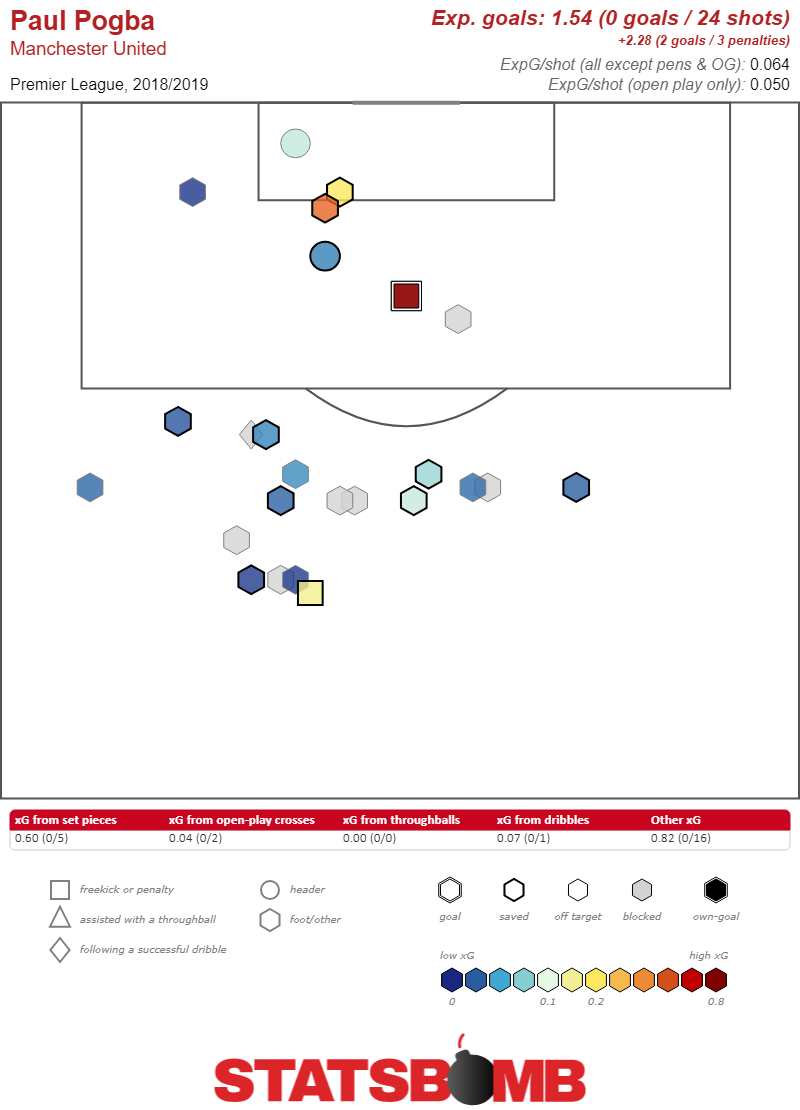 What lands him on the list though isn’t so much the fact that none of his Pog-bombs have detonated yet, it’s that he’s had too relatively high value shots from relatively close range saved. That’s similar to Mateo Kovacic who makes the list despite only taking 12 shots. It just so happens that one of them was a great chance after Olivier Giroud (himself on the list and nothing to worry about) played him clean through on goal.
What lands him on the list though isn’t so much the fact that none of his Pog-bombs have detonated yet, it’s that he’s had too relatively high value shots from relatively close range saved. That’s similar to Mateo Kovacic who makes the list despite only taking 12 shots. It just so happens that one of them was a great chance after Olivier Giroud (himself on the list and nothing to worry about) played him clean through on goal. 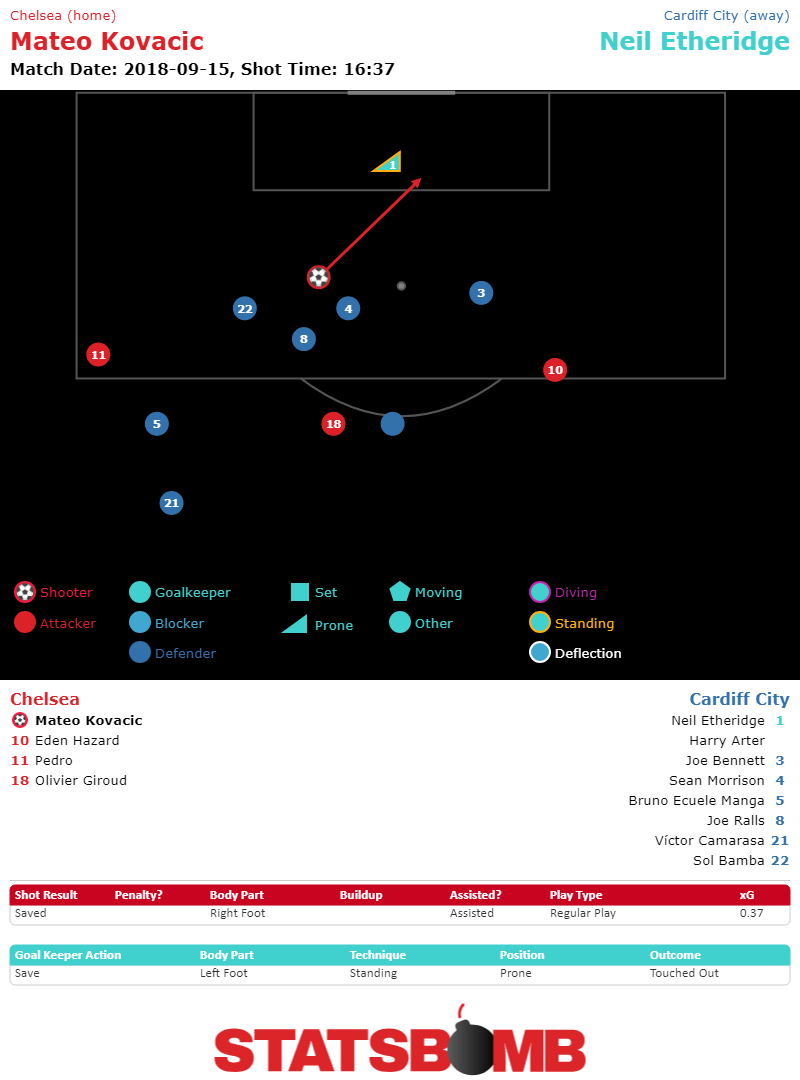 When it comes to players that don’t take a ton of great shots, performance against expected goals is going to be very very swingy. Slam one into the corner from 30 yards and you’ve bought yourself a bucket of potshots to miss while your numbers stay pretty. Fall victim to a fingertip save when you’re clean through on goal and you may not come across a similar chance to claw back your bad luck for a month. It’s just another example of why the level of expected goals is important, and the level of performance as compared to expected goals is going to fluctuate wildly. That doesn’t mean you always ignore those fluctuations. Christian Benteke is on this list. Benteke has no goals from 14 shots, and that’s exactly the kind of thing you’d ignore if it wasn’t for the fact that he also had two goals from open play last year on 57 shots, significantly undershooting his 8.36 expected goals. This might be nothing. But he’s also 27 with a horrific injury history and an unorthodox game that has always combined typical target man skills with some outrageously outlandish goals. It is reasonable to be skeptical of Benteke right now and to suspect that perhaps his game has deteriorated in a way that is opaque to expected goals. That doesn’t mean we should assume that to be the case, but we should at least be open to the possibility. In a related case, Danny Ings has a very robust 3.9 expected goals and a much less robust two actual goals. At 26, he’s actually not all that much younger than Benteke. After several years in the wilderness thanks to injury and lack of form at Liverpool, his Southampton revival marks a return to relevance for the striker. It’s worth asking whether his underperformance should raise similar concerns to Benteke’s given their similar age and injury history. The short answer is no. While Benteke’s underperformance has been going on for over a year, Ings is now only eight games into his renaissance. If he keeps missing at an understated rate all season long, then maybe it will be time to reconsider at the end of the season. If there’s one slight niggling concern with Ings it’s that he’s never put together a strong top-flight season before and he’s only had two total seasons where he’s scored double digit goals. He scored 21 goals on the way to getting Burnley promoted in 2013-14, and then scored 11 Premier League goals for Sean Dyche on the way to relegation in 2014-15. That’s kind of a thin track record for a 26-year-old. The question is how to reconcile that history with the current eight games which feature a robust expected goal tally, and a more limited goal tally. The easiest thing to do is just to adjust the excite-o-meter from super optimistic to cautiously optimistic. Ings looks good, his goal scoring should catch up to his numbers, but it’s worth being aware that without a track record things could end up not being quite as rosy as they seem. This, by the way, is equally applicable to Raul Jimenez at Wolves who has similarly impressive numbers at a similar age and with a similarly thin top-level track record. There are stories you could tell about why any given player might or might not be performing to the level expected goals predicts. It’s important to remember that most (but, crucially, not all) of these stories are wrong. Usually, everything works itself out eventually. But rarely, something weird is going on. To be nerdy about it, using tools like expected goals allows us to set a very strong null hypothesis. Expected goals is almost always right in the end. Good analysis means internalizing that fact while also being on guard for the potential exceptions. It’s a constant dance of assuming the stories you’re looking for will be wrong, but looking for them anyway just in case this one time is the exception to the rule.
When it comes to players that don’t take a ton of great shots, performance against expected goals is going to be very very swingy. Slam one into the corner from 30 yards and you’ve bought yourself a bucket of potshots to miss while your numbers stay pretty. Fall victim to a fingertip save when you’re clean through on goal and you may not come across a similar chance to claw back your bad luck for a month. It’s just another example of why the level of expected goals is important, and the level of performance as compared to expected goals is going to fluctuate wildly. That doesn’t mean you always ignore those fluctuations. Christian Benteke is on this list. Benteke has no goals from 14 shots, and that’s exactly the kind of thing you’d ignore if it wasn’t for the fact that he also had two goals from open play last year on 57 shots, significantly undershooting his 8.36 expected goals. This might be nothing. But he’s also 27 with a horrific injury history and an unorthodox game that has always combined typical target man skills with some outrageously outlandish goals. It is reasonable to be skeptical of Benteke right now and to suspect that perhaps his game has deteriorated in a way that is opaque to expected goals. That doesn’t mean we should assume that to be the case, but we should at least be open to the possibility. In a related case, Danny Ings has a very robust 3.9 expected goals and a much less robust two actual goals. At 26, he’s actually not all that much younger than Benteke. After several years in the wilderness thanks to injury and lack of form at Liverpool, his Southampton revival marks a return to relevance for the striker. It’s worth asking whether his underperformance should raise similar concerns to Benteke’s given their similar age and injury history. The short answer is no. While Benteke’s underperformance has been going on for over a year, Ings is now only eight games into his renaissance. If he keeps missing at an understated rate all season long, then maybe it will be time to reconsider at the end of the season. If there’s one slight niggling concern with Ings it’s that he’s never put together a strong top-flight season before and he’s only had two total seasons where he’s scored double digit goals. He scored 21 goals on the way to getting Burnley promoted in 2013-14, and then scored 11 Premier League goals for Sean Dyche on the way to relegation in 2014-15. That’s kind of a thin track record for a 26-year-old. The question is how to reconcile that history with the current eight games which feature a robust expected goal tally, and a more limited goal tally. The easiest thing to do is just to adjust the excite-o-meter from super optimistic to cautiously optimistic. Ings looks good, his goal scoring should catch up to his numbers, but it’s worth being aware that without a track record things could end up not being quite as rosy as they seem. This, by the way, is equally applicable to Raul Jimenez at Wolves who has similarly impressive numbers at a similar age and with a similarly thin top-level track record. There are stories you could tell about why any given player might or might not be performing to the level expected goals predicts. It’s important to remember that most (but, crucially, not all) of these stories are wrong. Usually, everything works itself out eventually. But rarely, something weird is going on. To be nerdy about it, using tools like expected goals allows us to set a very strong null hypothesis. Expected goals is almost always right in the end. Good analysis means internalizing that fact while also being on guard for the potential exceptions. It’s a constant dance of assuming the stories you’re looking for will be wrong, but looking for them anyway just in case this one time is the exception to the rule.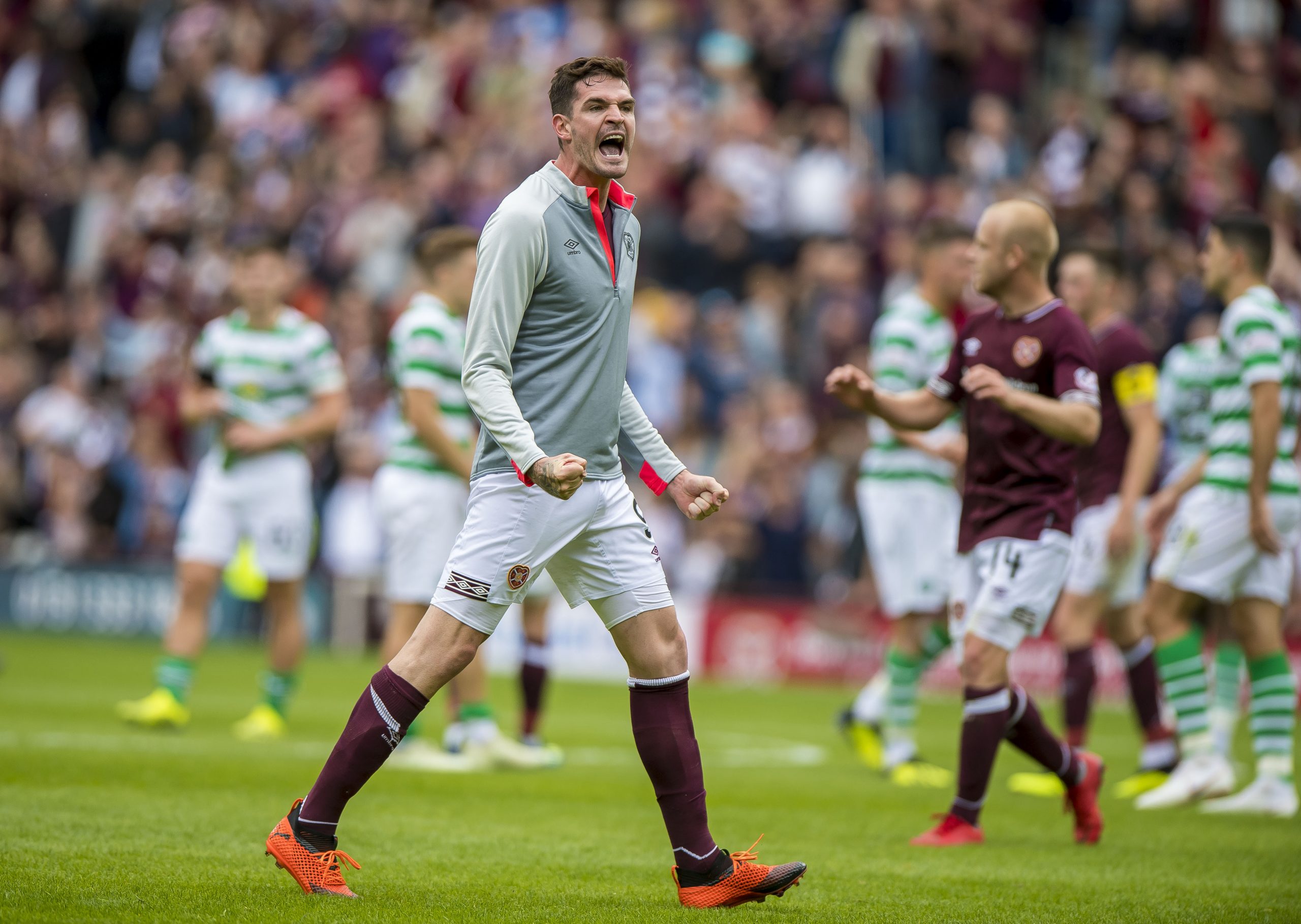
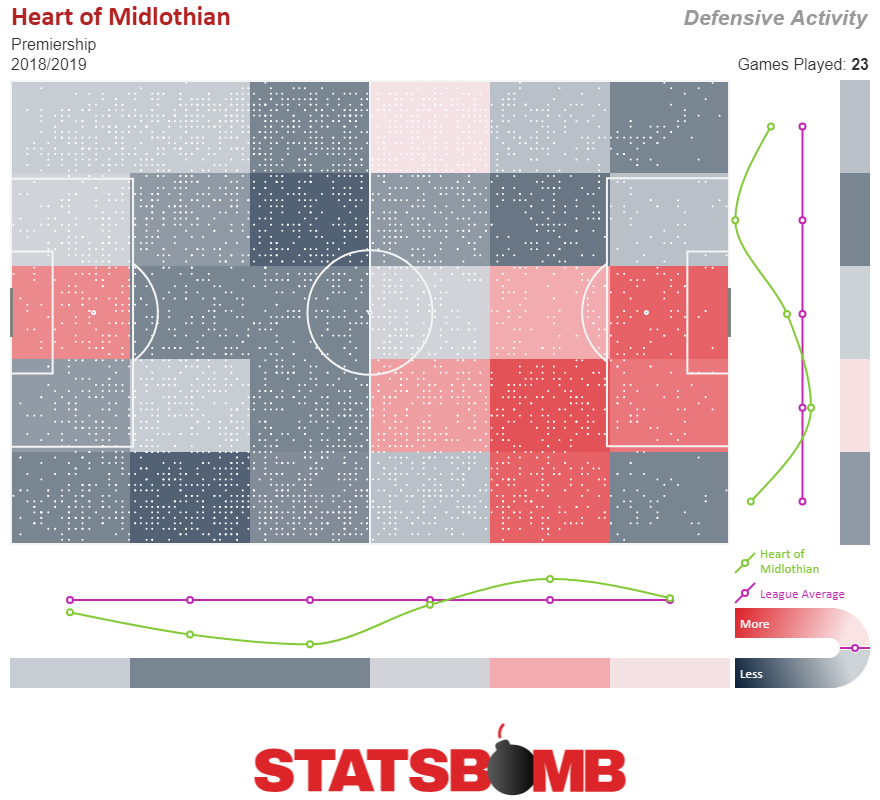 Hearts are something of a heavyweight boxer. They work the body with midfield aggressive actions by Peter Haring and Olly Lee. Steven Naismith buzzes around in your peripheral vision. They hit you a lot; taking both the second most shots and generating the second most expected goals per match in the league. Uche Ikpeazu and Steven MacLean rock your center backs relentlessly. Finally, either Haring or one of their young center back partnership of John Souttar and Jimmy Dunne delivers the incisive knock out blow from an expertly delivered set piece. A shot map of their set piece shots shows just how relentlessly focused they are at putting the ball on somebody's head right in front of goal.
Hearts are something of a heavyweight boxer. They work the body with midfield aggressive actions by Peter Haring and Olly Lee. Steven Naismith buzzes around in your peripheral vision. They hit you a lot; taking both the second most shots and generating the second most expected goals per match in the league. Uche Ikpeazu and Steven MacLean rock your center backs relentlessly. Finally, either Haring or one of their young center back partnership of John Souttar and Jimmy Dunne delivers the incisive knock out blow from an expertly delivered set piece. A shot map of their set piece shots shows just how relentlessly focused they are at putting the ball on somebody's head right in front of goal. 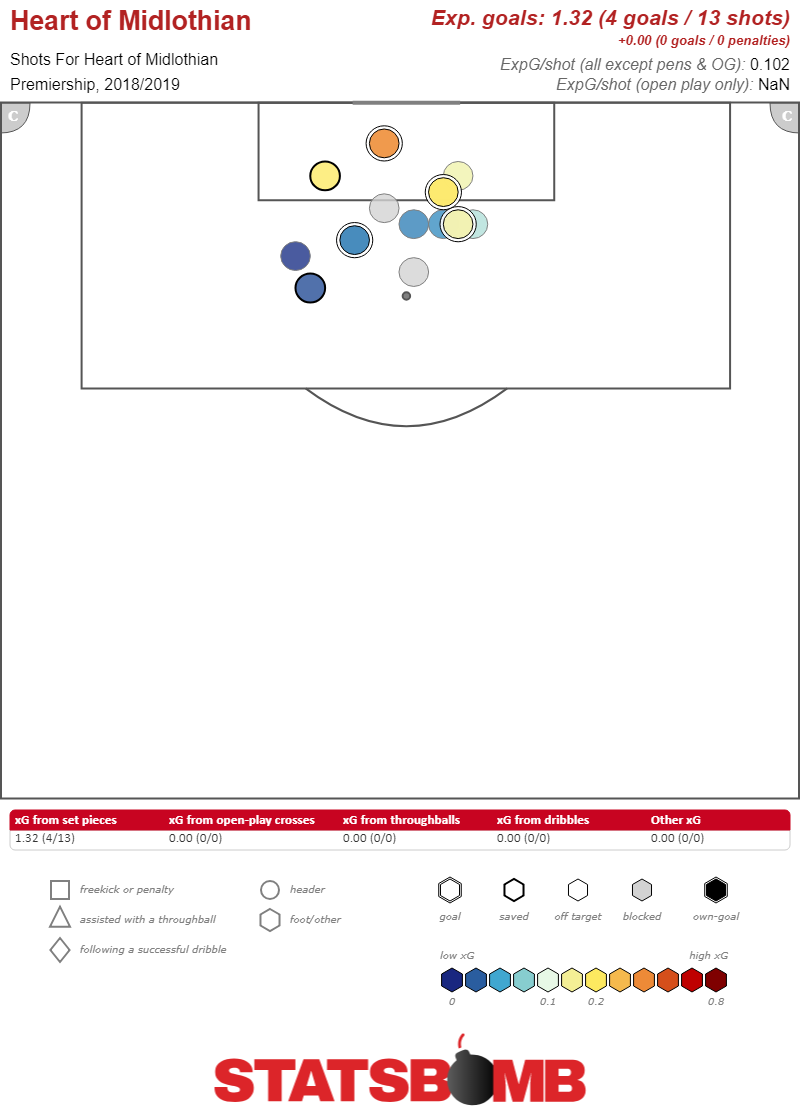 Hearts have the second highest xG from set pieces in the league. Just look at that central delivery from corners. They know how to keep their guard up in similar situations at the other end, conceding the lowest xG from set pieces in the division. However, there are some underlying reasons to suspect that they will not stay at the top. They are outperforming xG at both ends of the pitch. The average xG of the open play shots they take is the second lowest in the league. They concede at least two and a half more shots per match than the three teams sitting below them. They actually allow the second highest average xG per open play shot conceded. They've only conceded six goals but the StatsBomb xG model indicates they should have let in ten. Finally, this week they lost Souttar and Ikpeazu to injury for six months. An admirable start but that's a dizzying list of reasons why the Edinburgh club might not be quite ready for a shot at the title. A few miles east and just two points below their Edinburgh rivals are Hibs. Neil Lennon is another manager that's often ready with a wry quip to satisfy the narrative hungry Scottish game. Fortunately he's also pretty good at the on field side of things. Hibs have won their last four matches. They haven't conceded in the last three. This is all despite losing last season's first choice midfield; John McGinn to Aston Villa, Dylan McGeouch to Sunderland and Scott Allan to Celtic. Lennon has adapted, and his side are playing some excellent, brave football. Their goalkeeper takes the second shortest passes and they make the second most passes per match in the league but they move up the pitch quickly.
Hearts have the second highest xG from set pieces in the league. Just look at that central delivery from corners. They know how to keep their guard up in similar situations at the other end, conceding the lowest xG from set pieces in the division. However, there are some underlying reasons to suspect that they will not stay at the top. They are outperforming xG at both ends of the pitch. The average xG of the open play shots they take is the second lowest in the league. They concede at least two and a half more shots per match than the three teams sitting below them. They actually allow the second highest average xG per open play shot conceded. They've only conceded six goals but the StatsBomb xG model indicates they should have let in ten. Finally, this week they lost Souttar and Ikpeazu to injury for six months. An admirable start but that's a dizzying list of reasons why the Edinburgh club might not be quite ready for a shot at the title. A few miles east and just two points below their Edinburgh rivals are Hibs. Neil Lennon is another manager that's often ready with a wry quip to satisfy the narrative hungry Scottish game. Fortunately he's also pretty good at the on field side of things. Hibs have won their last four matches. They haven't conceded in the last three. This is all despite losing last season's first choice midfield; John McGinn to Aston Villa, Dylan McGeouch to Sunderland and Scott Allan to Celtic. Lennon has adapted, and his side are playing some excellent, brave football. Their goalkeeper takes the second shortest passes and they make the second most passes per match in the league but they move up the pitch quickly. 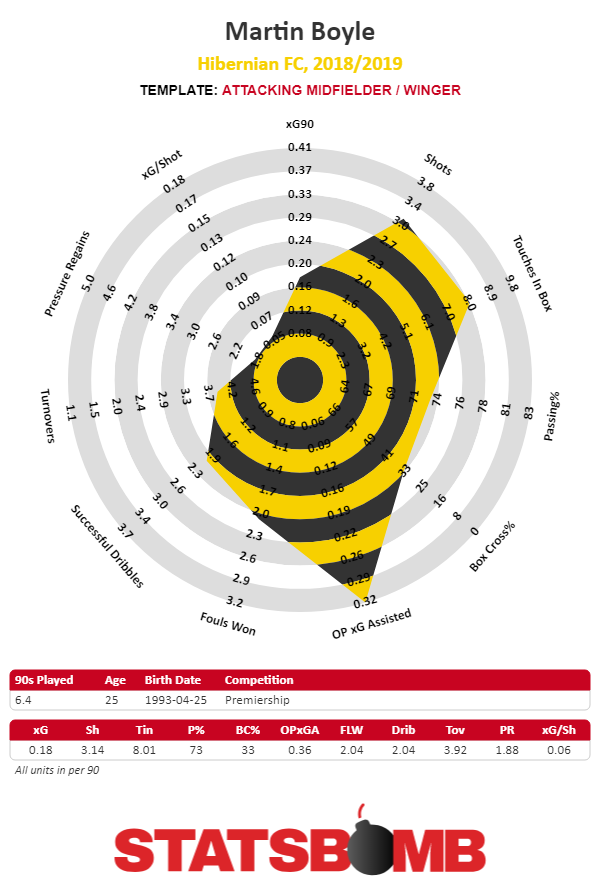 Their wingers, led by Martin Boyle, are heavily involved in creating chances. If that doesn't work their midfielders are poised to win the ball back rapidly. Emerson Hyndman is making almost five pressure regains every match. They're not just winning the ball back to pass it about. They take the third most shots in the league. Tellingly, they top the table for 'high press' shots - ones shortly after they've regained possession. In addition they are second for 'clear shots' - ones with only the goalkeeper between shooter and goal. Although they do concede the third highest average xG per open play shot they are good at limiting chances. The centre back combination of ball player Efe Ambrose and young, aggressive Ryan Porteous has helped them concede the second fewest shots and third lowest xG per game.
Their wingers, led by Martin Boyle, are heavily involved in creating chances. If that doesn't work their midfielders are poised to win the ball back rapidly. Emerson Hyndman is making almost five pressure regains every match. They're not just winning the ball back to pass it about. They take the third most shots in the league. Tellingly, they top the table for 'high press' shots - ones shortly after they've regained possession. In addition they are second for 'clear shots' - ones with only the goalkeeper between shooter and goal. Although they do concede the third highest average xG per open play shot they are good at limiting chances. The centre back combination of ball player Efe Ambrose and young, aggressive Ryan Porteous has helped them concede the second fewest shots and third lowest xG per game. 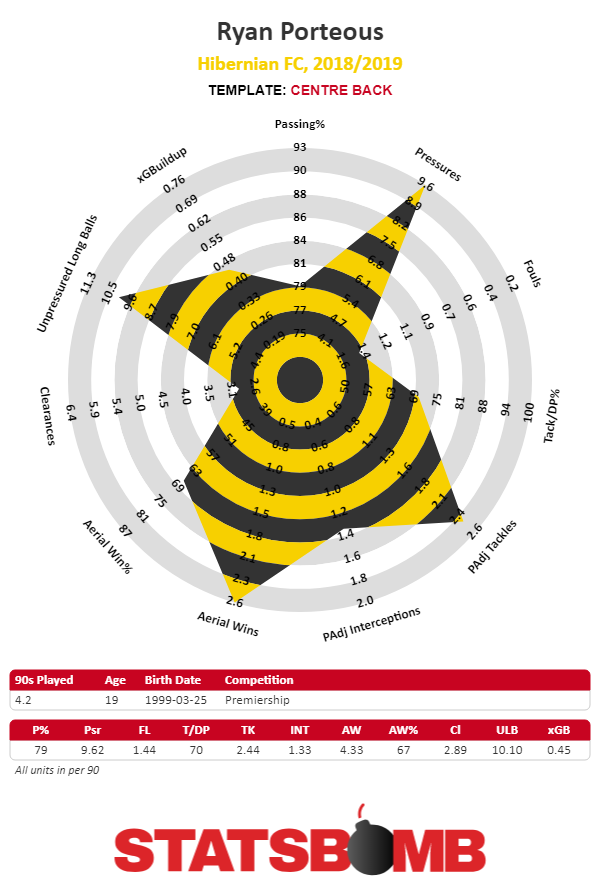 Back to the west and there have been dark clouds hanging over Celtic Park. Grumbles about player recruitment persist from both fans and the manager. Rival fans are joking about fancy lighting bought for Champions League nights, a competition they failed to qualify for. There are rumors of a dressing room split after last minute transfer window maneuvers. That all sets the scene for a start in which the teams has only scored seven goals in their first seven matches. Third place for a club which were invincible and scored 106 goals in the 2016/17 season? It doesn't look good. But, despite the doom and gloom, things might not actually be all that bad. Celtic have the highest xG per match. They concede the lowest xG per match. They have the highest xG from set pieces per match. They take the most shots per match. They concede the fewest shots per match. They allow the lowest average xG per open play shot conceded. They've been slow out of the blocks but those are the underlying numbers of champions in waiting.
Back to the west and there have been dark clouds hanging over Celtic Park. Grumbles about player recruitment persist from both fans and the manager. Rival fans are joking about fancy lighting bought for Champions League nights, a competition they failed to qualify for. There are rumors of a dressing room split after last minute transfer window maneuvers. That all sets the scene for a start in which the teams has only scored seven goals in their first seven matches. Third place for a club which were invincible and scored 106 goals in the 2016/17 season? It doesn't look good. But, despite the doom and gloom, things might not actually be all that bad. Celtic have the highest xG per match. They concede the lowest xG per match. They have the highest xG from set pieces per match. They take the most shots per match. They concede the fewest shots per match. They allow the lowest average xG per open play shot conceded. They've been slow out of the blocks but those are the underlying numbers of champions in waiting. 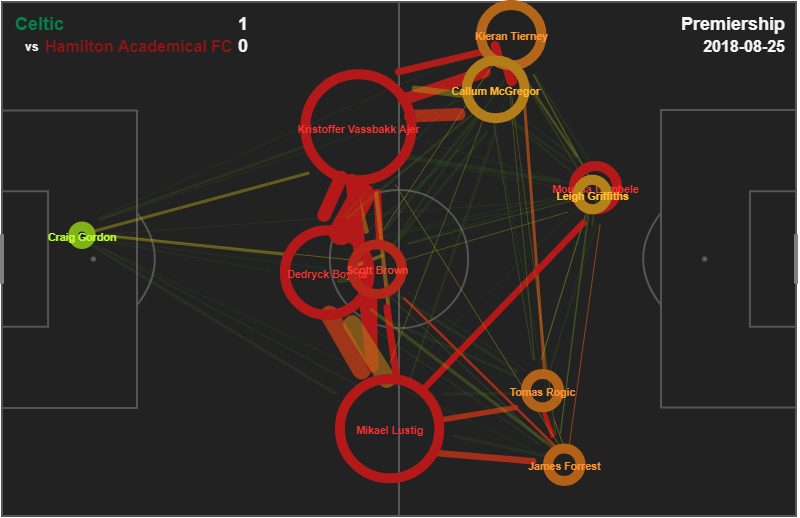 There have been problems. Early season criticism was aimed at defensive errors especially from Jack Hendry. Odsonne Edouard was viewed as not managing to shoot enough. The key issue is that Celtic have struggled to make high quality chances. Sure, teams sit deep against them but that's been the case before. The Hoops miss the central combination play of Moussa Dembele and Stuart Armstrong. There has been a real lack of quick ball progression out of defense. Scott Brown is now thirty-three but still demands the ball like a young pup. He is needlessly slowing progress into dangerous zones. Kristoffer Ajer hasn't made the line breaking runs into midfield that seemed to be his standard operating procedure. Mikael Lustig has been deployed as a third center back. His sole function there appears to be to exchange sideways pass after sideways pass with Dedryck Boyata.
There have been problems. Early season criticism was aimed at defensive errors especially from Jack Hendry. Odsonne Edouard was viewed as not managing to shoot enough. The key issue is that Celtic have struggled to make high quality chances. Sure, teams sit deep against them but that's been the case before. The Hoops miss the central combination play of Moussa Dembele and Stuart Armstrong. There has been a real lack of quick ball progression out of defense. Scott Brown is now thirty-three but still demands the ball like a young pup. He is needlessly slowing progress into dangerous zones. Kristoffer Ajer hasn't made the line breaking runs into midfield that seemed to be his standard operating procedure. Mikael Lustig has been deployed as a third center back. His sole function there appears to be to exchange sideways pass after sideways pass with Dedryck Boyata. 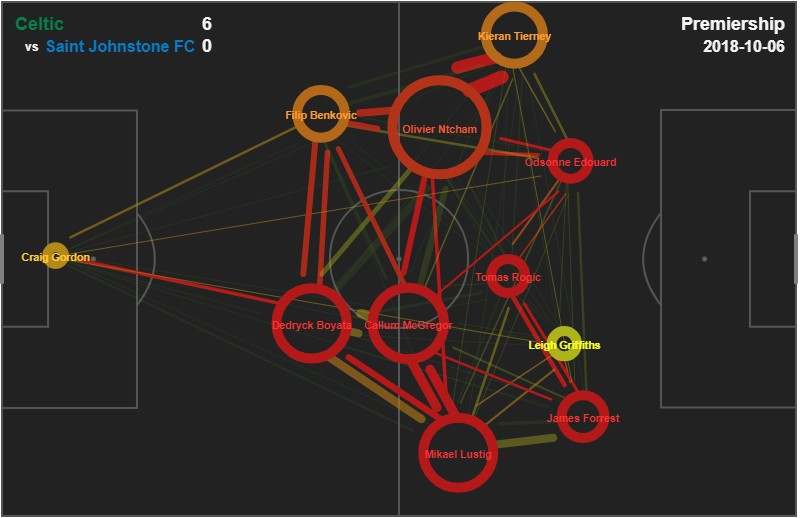 Consider the difference in Celtic's most recent match with Brown rested and Lustig played as a right back. There are still issues. An imbalanced squad heavy on wingers. Wastefulness from James Forrest (don't be fooled by that four goal haul in one match). Firefighting is often needed behind Lustig. However, if Celtic can continue to play this way they should be at the top of the table soon.
Consider the difference in Celtic's most recent match with Brown rested and Lustig played as a right back. There are still issues. An imbalanced squad heavy on wingers. Wastefulness from James Forrest (don't be fooled by that four goal haul in one match). Firefighting is often needed behind Lustig. However, if Celtic can continue to play this way they should be at the top of the table soon. 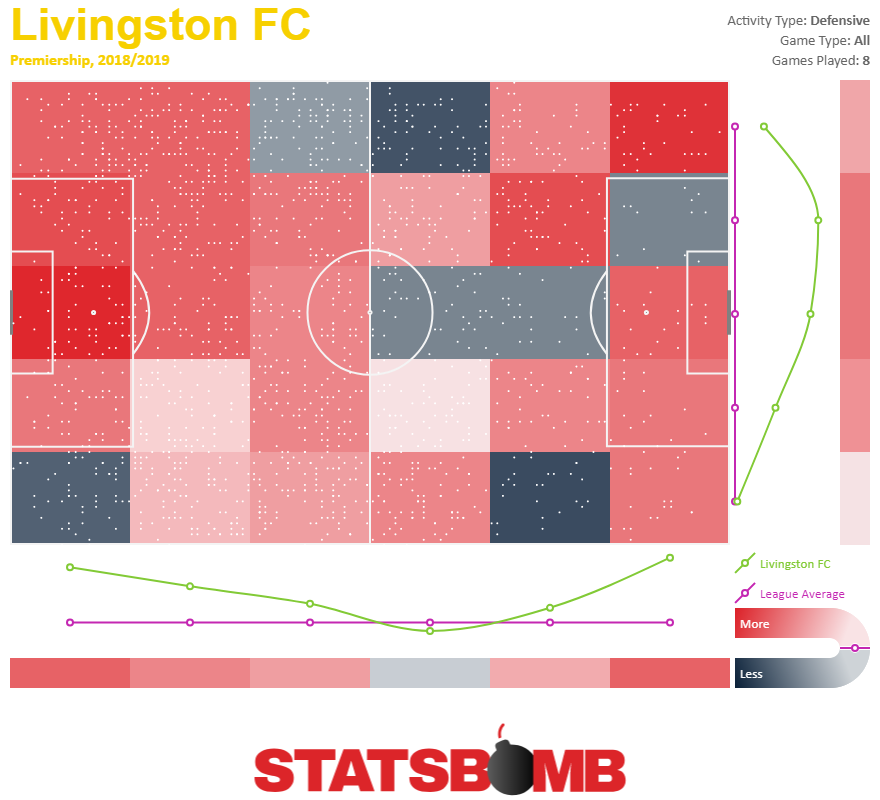 In fifth place is the season's surprise package. Livingston are little changed despite the departure of manager David Hopkin post promotion and the hiring and firing of veteran striker Kenny Miller as player manager. Playing at the Tony Macaroni Arena, sponsored by a local Italian restaurant, they aggressively attack all over the plastic pitch. A flood of pressure smothers the opposition. It's hard not to think of their sponsor's Macaroni Cheese Lasagne smothering arteries with a mix of four cheeses and two types of pasta. On field, the goal is to funnel the opposition into directing high balls into the box. Livingston's defenders eat them up like they were dough ball starters. The West Lothian club are profiling like a mid table side, creating the seventh highest and conceding the fifth lowest xG per match. They could be due a bit of a dip though as they have outperformed xG defensively quite significantly.
In fifth place is the season's surprise package. Livingston are little changed despite the departure of manager David Hopkin post promotion and the hiring and firing of veteran striker Kenny Miller as player manager. Playing at the Tony Macaroni Arena, sponsored by a local Italian restaurant, they aggressively attack all over the plastic pitch. A flood of pressure smothers the opposition. It's hard not to think of their sponsor's Macaroni Cheese Lasagne smothering arteries with a mix of four cheeses and two types of pasta. On field, the goal is to funnel the opposition into directing high balls into the box. Livingston's defenders eat them up like they were dough ball starters. The West Lothian club are profiling like a mid table side, creating the seventh highest and conceding the fifth lowest xG per match. They could be due a bit of a dip though as they have outperformed xG defensively quite significantly. 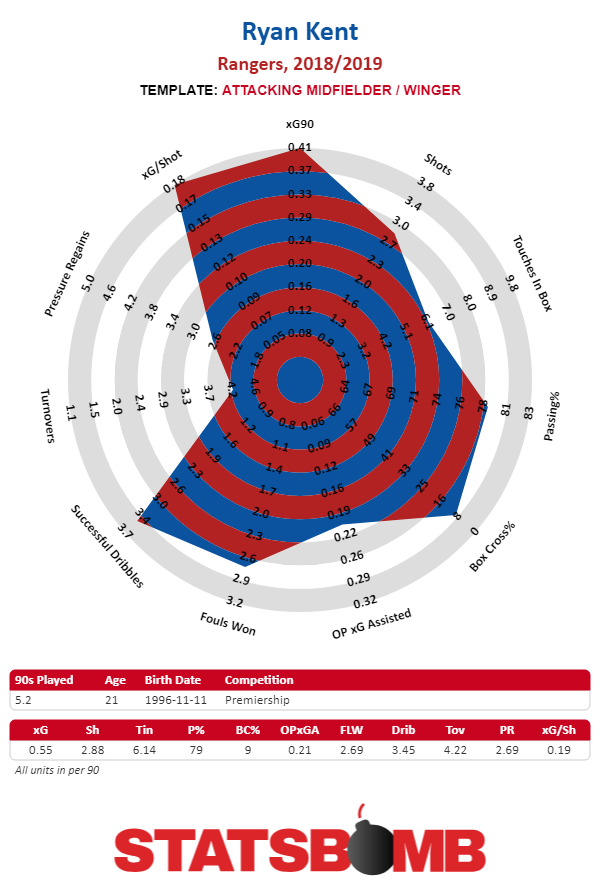 Exciting times over at Ibrox with Rangers creating the second highest xG per game. They do this by carving out really good chances. They make the most 'clear shots' and have the highest xG per open play shot in the league. Often they overload the right side with James Tavernier, Daniel Candeias, Scott Arfield and Alfredo Morelos linking up well. On the left, young loanee Ryan Kent has stepped in for inured Jamie Murphy to great effect. When Steven Gerrard has altered this 4-3-3 set up to introduce Kyle Lafferty as an aerial weapon they have struggled. This was the case against Motherwell, Livingston and Celtic. Apart from having courage in his convictions, what is needed for Gerrard to get Rangers up the table? Smart squad management given Europa League commitments and some work on set pieces given they concede the second highest xG from them per match in the league.
Exciting times over at Ibrox with Rangers creating the second highest xG per game. They do this by carving out really good chances. They make the most 'clear shots' and have the highest xG per open play shot in the league. Often they overload the right side with James Tavernier, Daniel Candeias, Scott Arfield and Alfredo Morelos linking up well. On the left, young loanee Ryan Kent has stepped in for inured Jamie Murphy to great effect. When Steven Gerrard has altered this 4-3-3 set up to introduce Kyle Lafferty as an aerial weapon they have struggled. This was the case against Motherwell, Livingston and Celtic. Apart from having courage in his convictions, what is needed for Gerrard to get Rangers up the table? Smart squad management given Europa League commitments and some work on set pieces given they concede the second highest xG from them per match in the league. 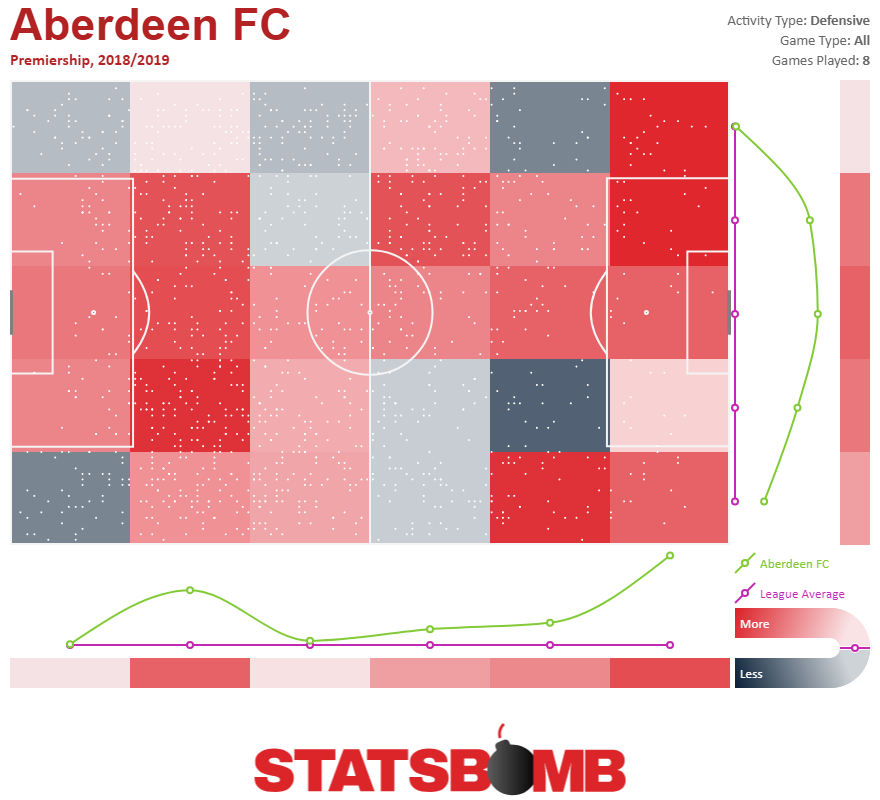 Aberdeen finished the last two seasons in second. This time they look very much like a mid-table team. They take the fifth most shots and allow the sixth fewest shots. They create the sixth most and concede the fourth lowest xG per match. How are they achieving all this mediocrity? Well they lost two of their central creative outlets, Ryan Christie and Kenny McLean, in the summer. Now they get it wide and swing crosses in. Not the smartest route to goal. Stevie May is yet to score and Sam Cosgrove is only getting low value headed opportunities. At the other end they tend to man mark in midfield and then manfully block from the edge of the box. Aberdeen are marginally overperforming xG conceded but are within a position or two of where they deserve to be. An even more blocking orientated team are St Johnstone. They allow the most opposition passes per match. They concede the most shots per match in the league. A massive 21.63. However, they allow the second lowest xG per open play shot. They have managed to block just under a third of all the shots they've faced.
Aberdeen finished the last two seasons in second. This time they look very much like a mid-table team. They take the fifth most shots and allow the sixth fewest shots. They create the sixth most and concede the fourth lowest xG per match. How are they achieving all this mediocrity? Well they lost two of their central creative outlets, Ryan Christie and Kenny McLean, in the summer. Now they get it wide and swing crosses in. Not the smartest route to goal. Stevie May is yet to score and Sam Cosgrove is only getting low value headed opportunities. At the other end they tend to man mark in midfield and then manfully block from the edge of the box. Aberdeen are marginally overperforming xG conceded but are within a position or two of where they deserve to be. An even more blocking orientated team are St Johnstone. They allow the most opposition passes per match. They concede the most shots per match in the league. A massive 21.63. However, they allow the second lowest xG per open play shot. They have managed to block just under a third of all the shots they've faced. 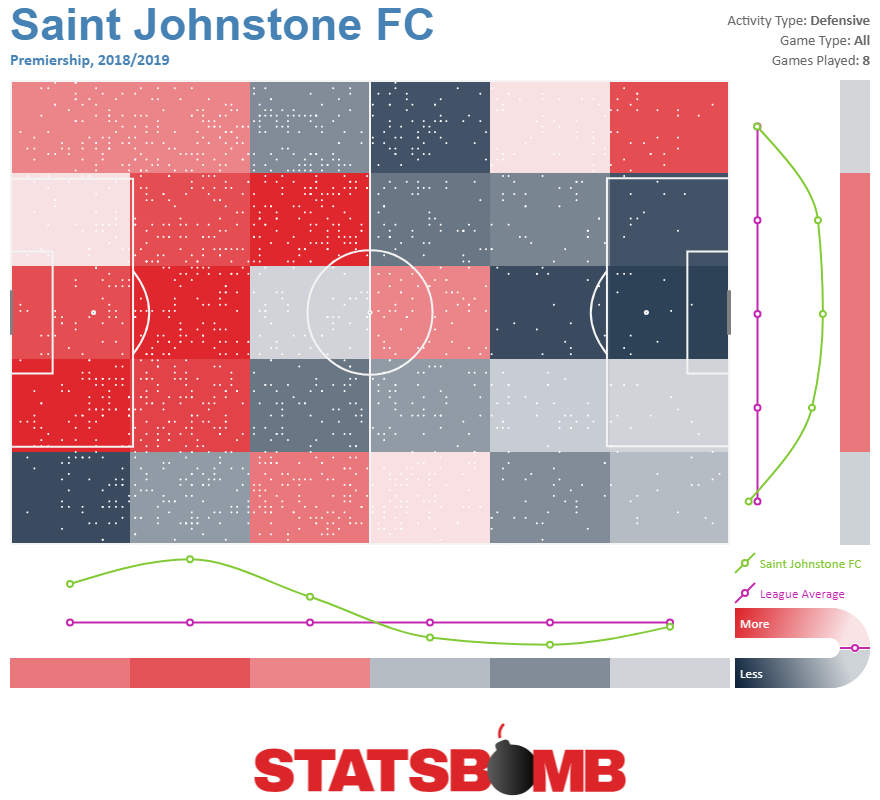 Defending like this can backfire. They've conceded eleven goals in their matches against Rangers and Celtic. Up next are critical matches against struggling Motherwell and St Mirren. Fail to win those and they will be drawn into the relegation battle.
Defending like this can backfire. They've conceded eleven goals in their matches against Rangers and Celtic. Up next are critical matches against struggling Motherwell and St Mirren. Fail to win those and they will be drawn into the relegation battle. 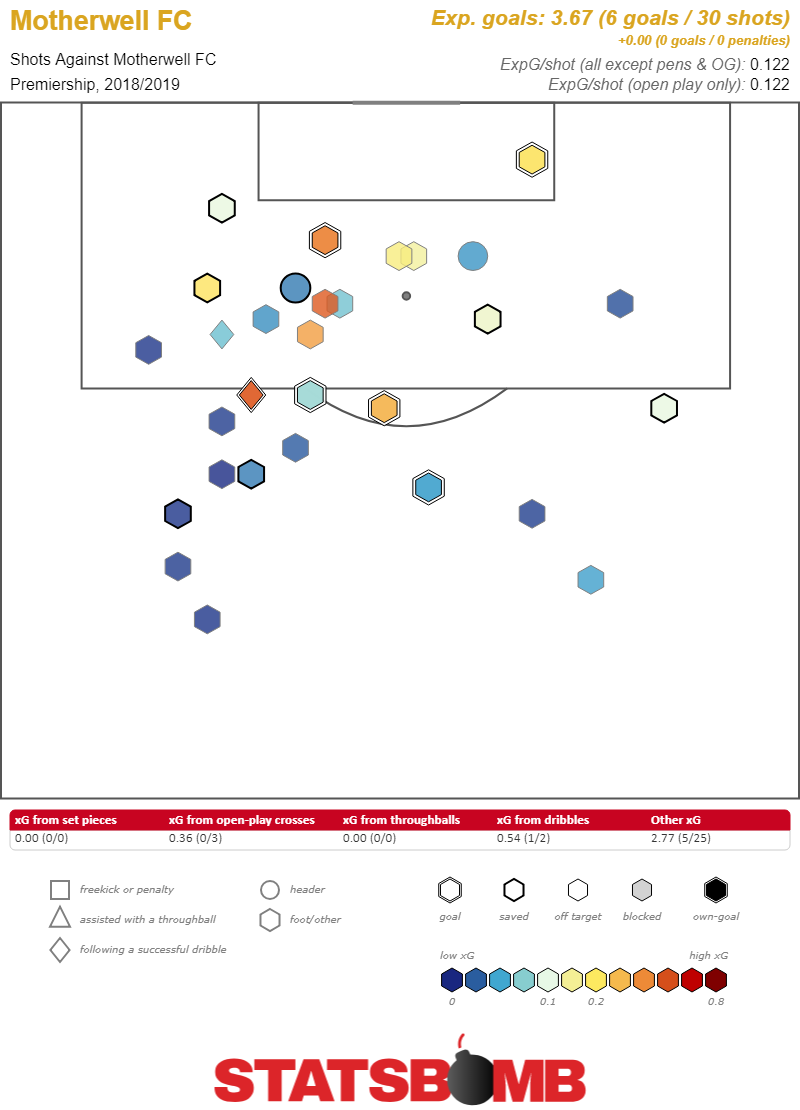 However, they do allow the fourth most shots per match. A lot of the open play shots they are conceding are from the zone Cedric Kipre defended before his August move to Wigan Athletic. An upturn in goalkeeper Scott Carson's form and a replacement for Kipre might be vital building blocks for Motherwell's resurgence. St Mirren's new manager Oran Kearney has his work cut out. Poor recruitment has left the side looking ill equipped throughout. One loanee, Nicolai Brock-Madsen, has been sent back to his parent club this week after the striker managed just one shot in over four hours on the pitch. He's not been the only failure in this area. The side have created only fifty shots from open play and have the lowest xG per game in the league. No surprise that they've scored the fewest goals. They're also passive defensively. They allow the highest opposition pass completion, give up good shooting opportunities and struggle to save the resulting shots. Of the thirty seven unblocked shots that have landed on target from open play against them fourteen have gone in.
However, they do allow the fourth most shots per match. A lot of the open play shots they are conceding are from the zone Cedric Kipre defended before his August move to Wigan Athletic. An upturn in goalkeeper Scott Carson's form and a replacement for Kipre might be vital building blocks for Motherwell's resurgence. St Mirren's new manager Oran Kearney has his work cut out. Poor recruitment has left the side looking ill equipped throughout. One loanee, Nicolai Brock-Madsen, has been sent back to his parent club this week after the striker managed just one shot in over four hours on the pitch. He's not been the only failure in this area. The side have created only fifty shots from open play and have the lowest xG per game in the league. No surprise that they've scored the fewest goals. They're also passive defensively. They allow the highest opposition pass completion, give up good shooting opportunities and struggle to save the resulting shots. Of the thirty seven unblocked shots that have landed on target from open play against them fourteen have gone in. 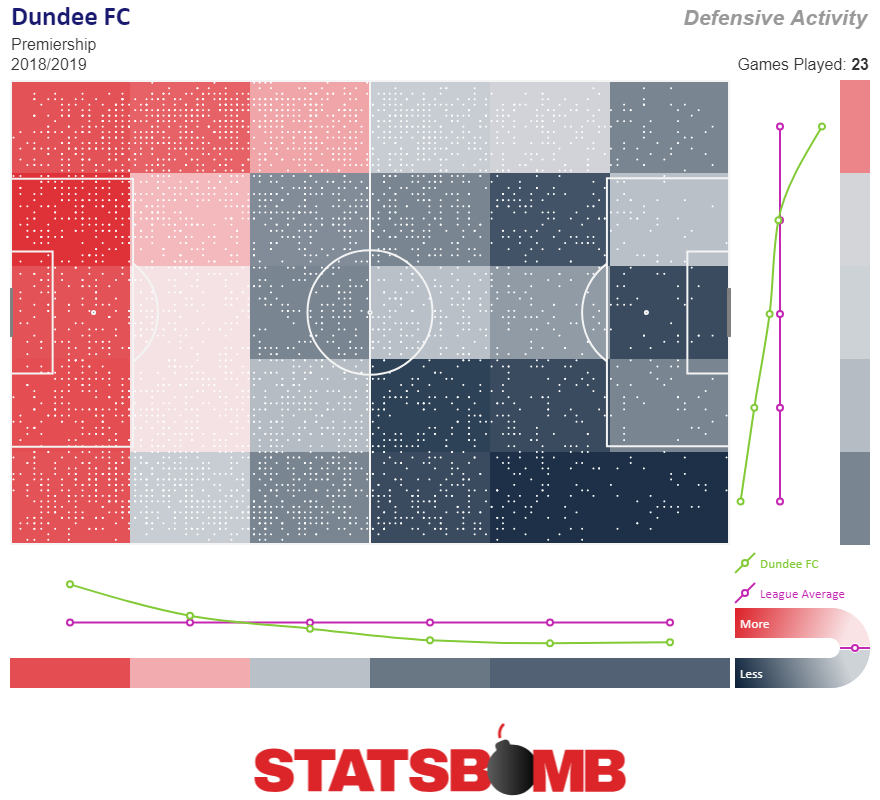 In dead last with one win and seven losses are Dundee FC. After persistent rumors they sacked Neil McCann this week and replaced him with Jim McIntyre. Under McCann, they liked to pass it around but were a bit unsure of themselves when they entered the final third. They made the sixth most passes per game but took the fourth fewest shots. Those shots had the lowest average xG in the league. Fifty three of the seventy five open play shots they've attempted were blocked or off target. They've made the third fewest aggressive actions per match and concede great swathes of territory out of possession. This has led to them conceding the second most shots in the league. Worse still the open play shots that they faced (shown below) had the highest average xG in the division.
In dead last with one win and seven losses are Dundee FC. After persistent rumors they sacked Neil McCann this week and replaced him with Jim McIntyre. Under McCann, they liked to pass it around but were a bit unsure of themselves when they entered the final third. They made the sixth most passes per game but took the fourth fewest shots. Those shots had the lowest average xG in the league. Fifty three of the seventy five open play shots they've attempted were blocked or off target. They've made the third fewest aggressive actions per match and concede great swathes of territory out of possession. This has led to them conceding the second most shots in the league. Worse still the open play shots that they faced (shown below) had the highest average xG in the division. 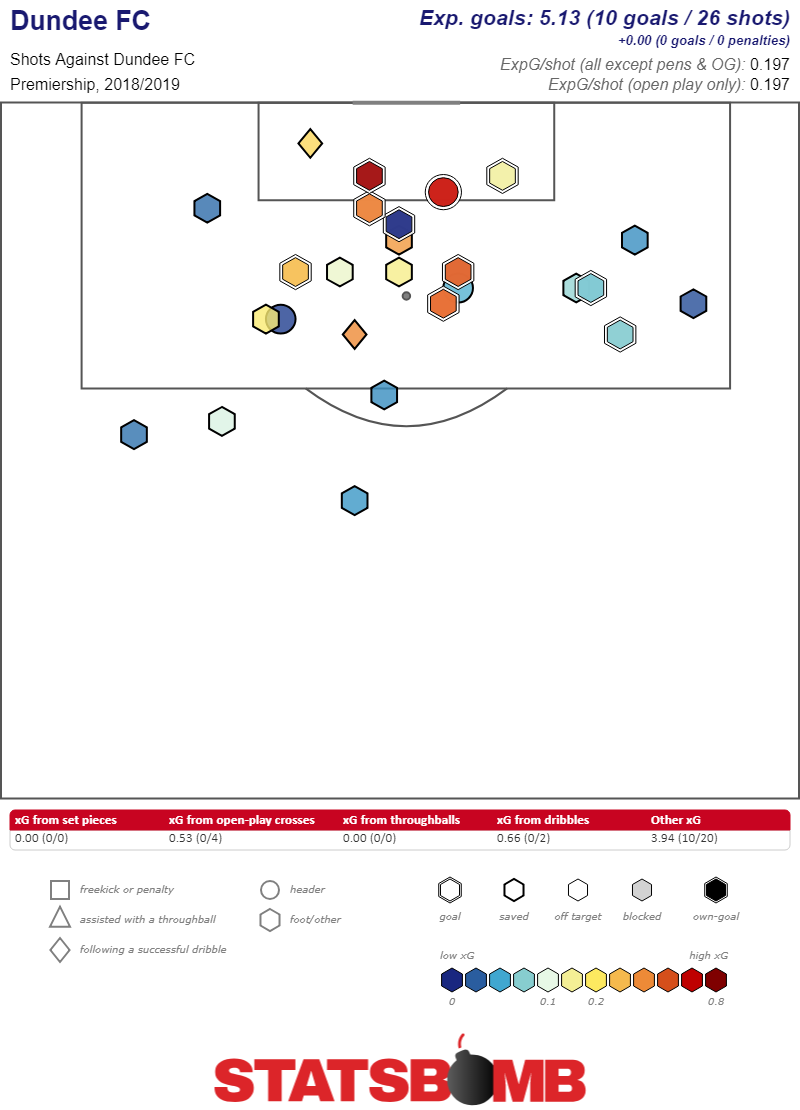 All this stacked on top of each other computes quite simply as the third lowest xG for and the highest xG against in the SPFL Premiership. Major improvements are needed if they are to have any chance of survival. So, after eight weeks no team is winless and no team is undefeated. The table does have an unfamiliar feel. However, Celtic's underlying numbers make it look like they should win the league. Hearts, Hibs, Kilmarnock and Rangers will contest the European spots and be a real threat in the Scottish Cup. Motherwell should rise clear of the dogfight and join Livingston, Aberdeen and St Johnstone in mid-table. It's going to be a real scrap for survival between Hamilton, St Mirren and Dundee. Header image courtesy of the Press Association
All this stacked on top of each other computes quite simply as the third lowest xG for and the highest xG against in the SPFL Premiership. Major improvements are needed if they are to have any chance of survival. So, after eight weeks no team is winless and no team is undefeated. The table does have an unfamiliar feel. However, Celtic's underlying numbers make it look like they should win the league. Hearts, Hibs, Kilmarnock and Rangers will contest the European spots and be a real threat in the Scottish Cup. Motherwell should rise clear of the dogfight and join Livingston, Aberdeen and St Johnstone in mid-table. It's going to be a real scrap for survival between Hamilton, St Mirren and Dundee. Header image courtesy of the Press Association